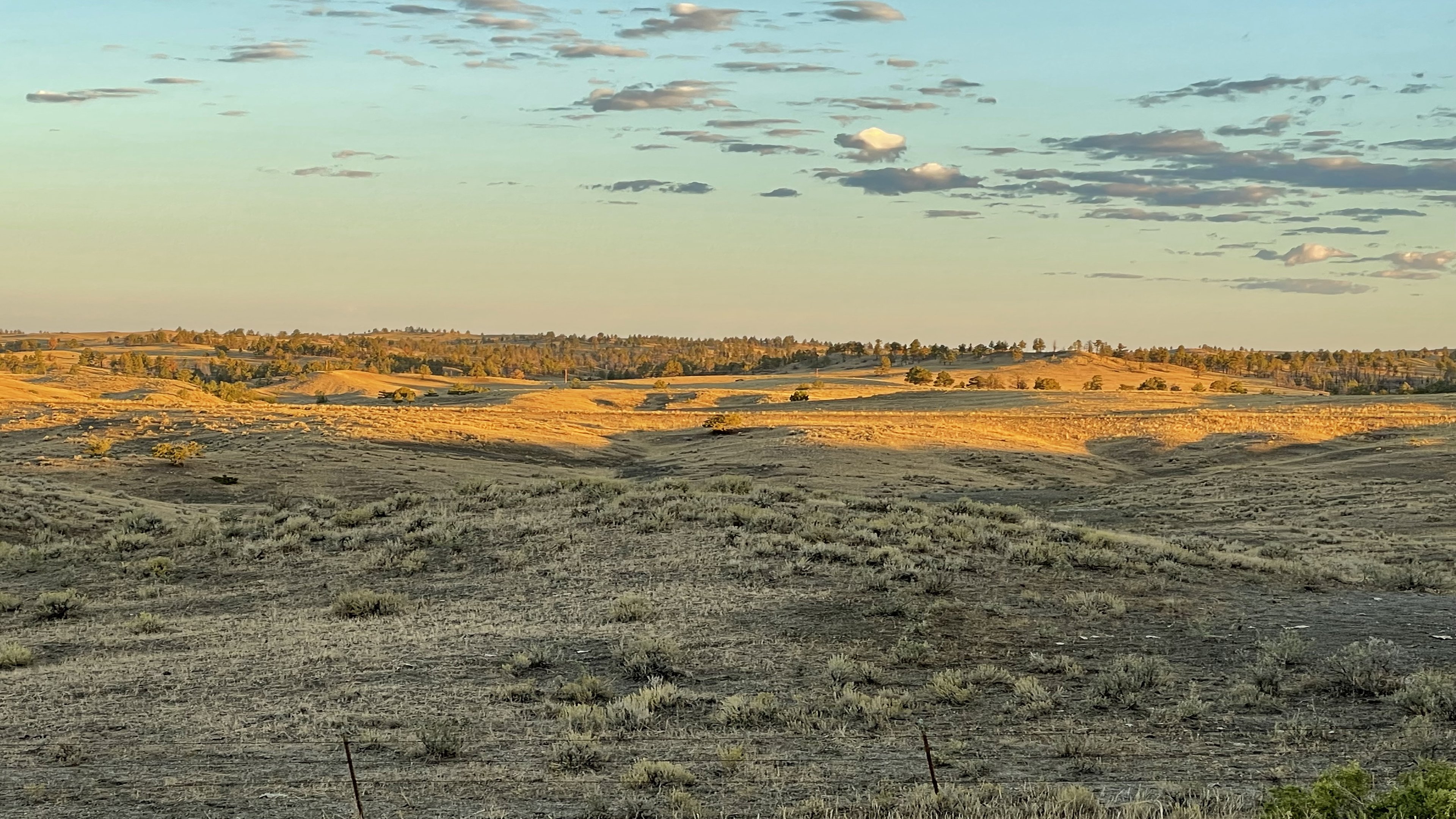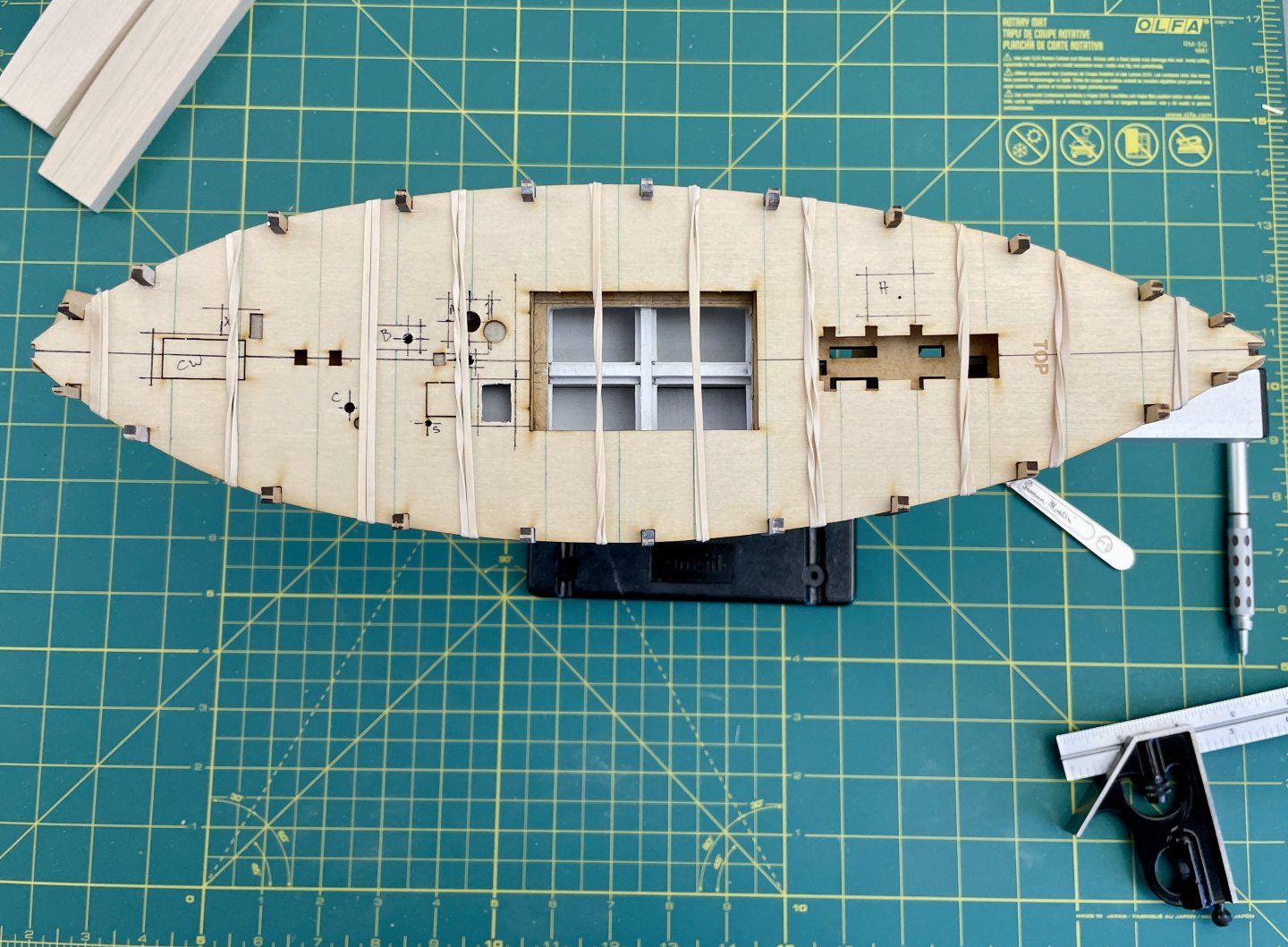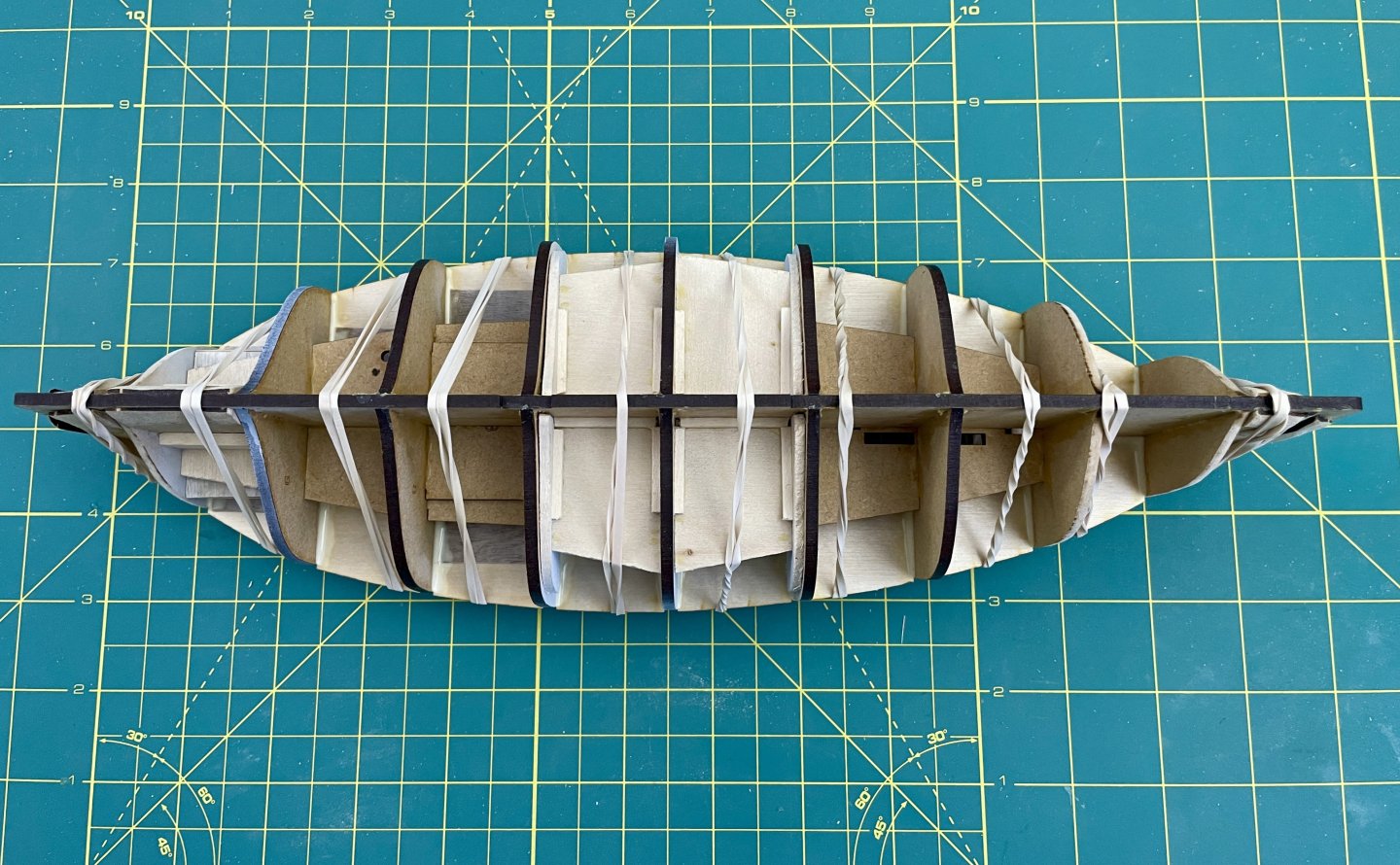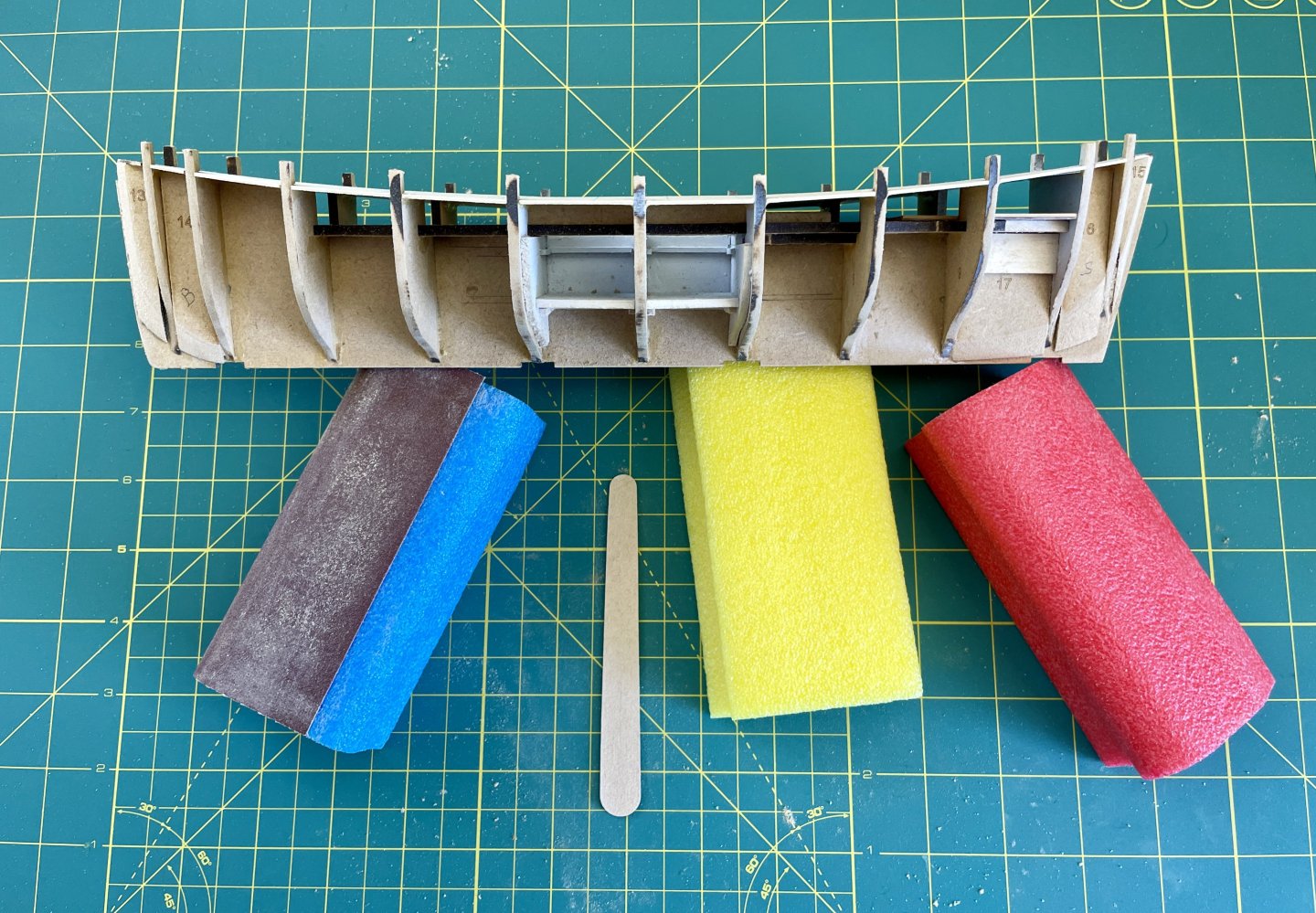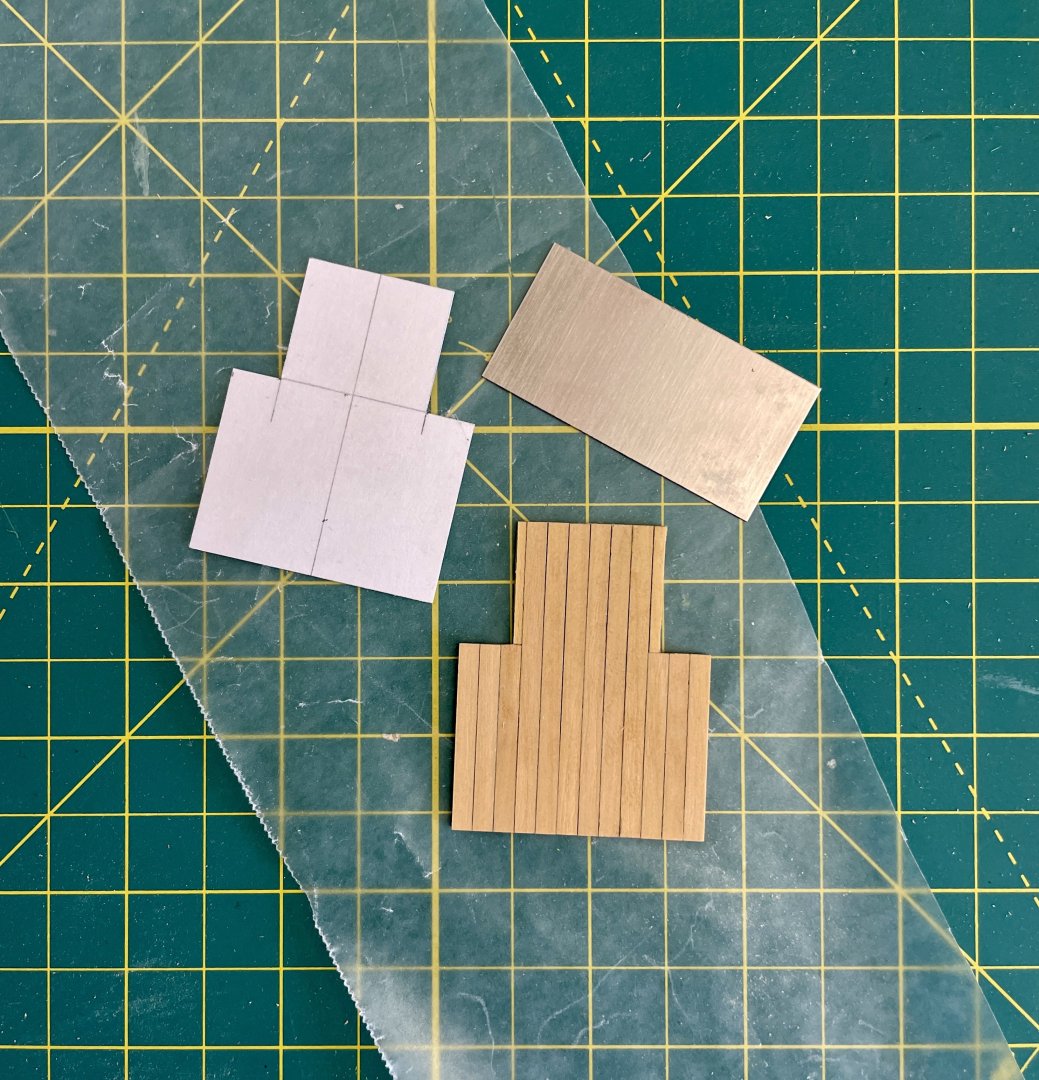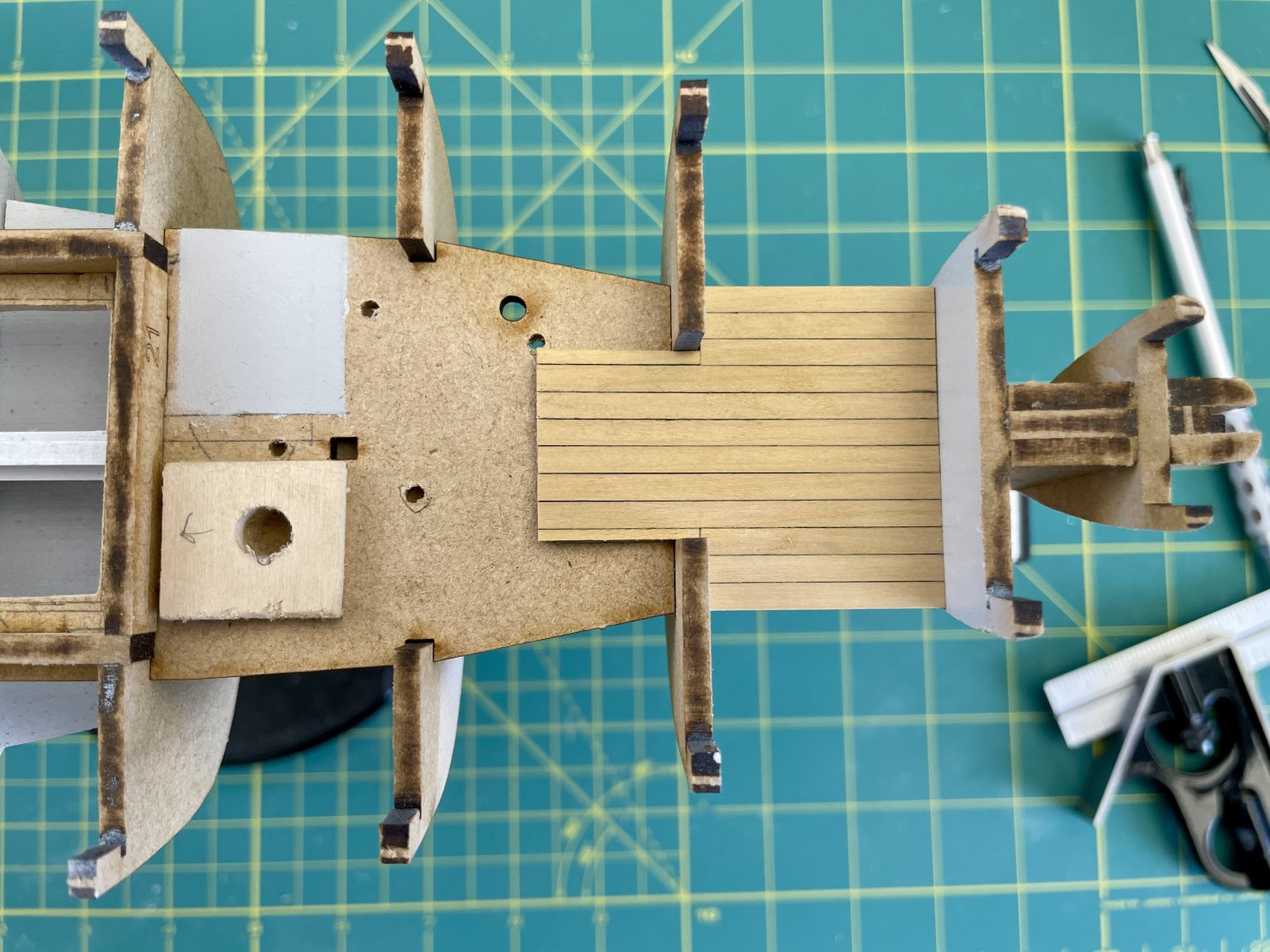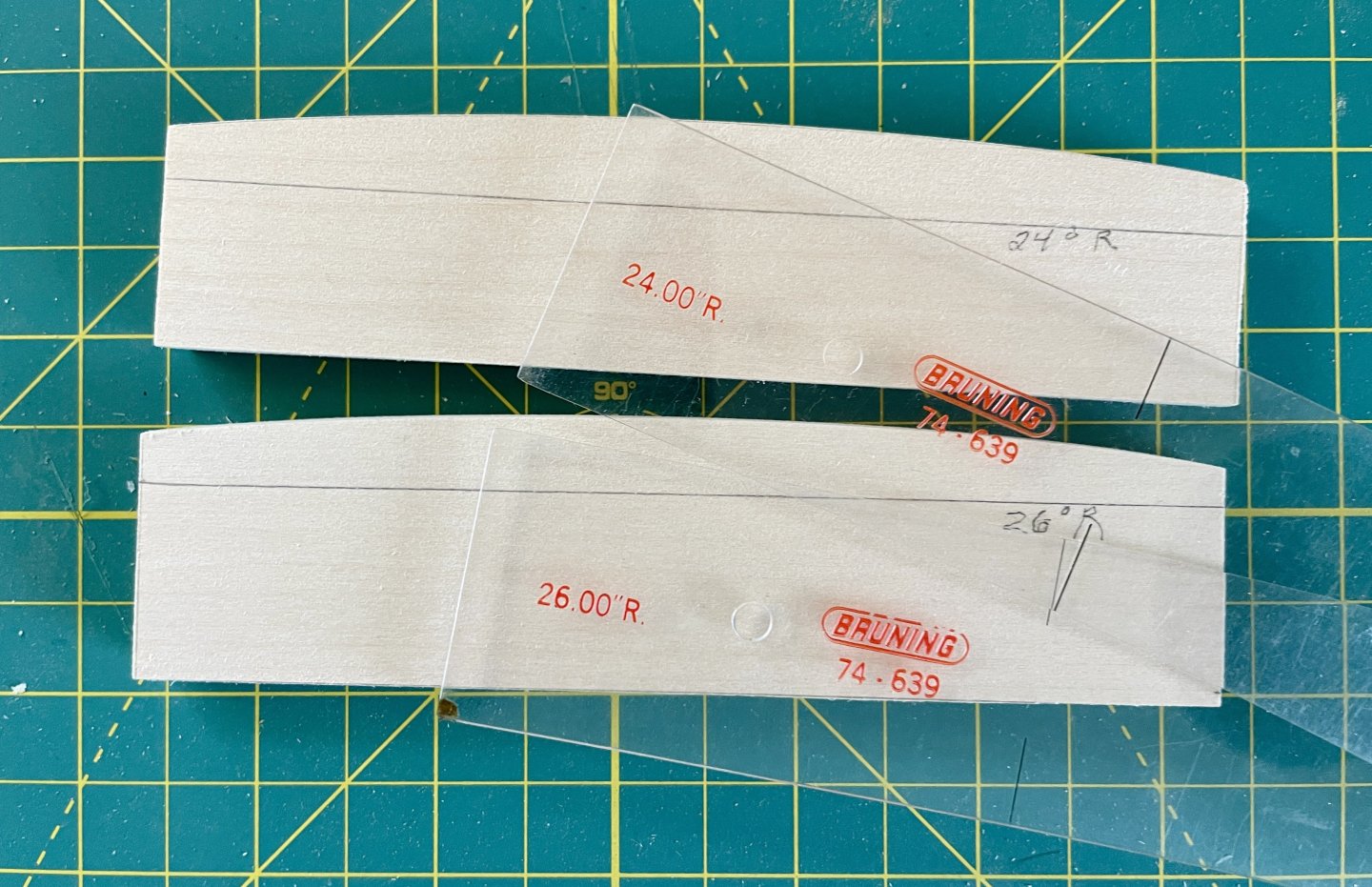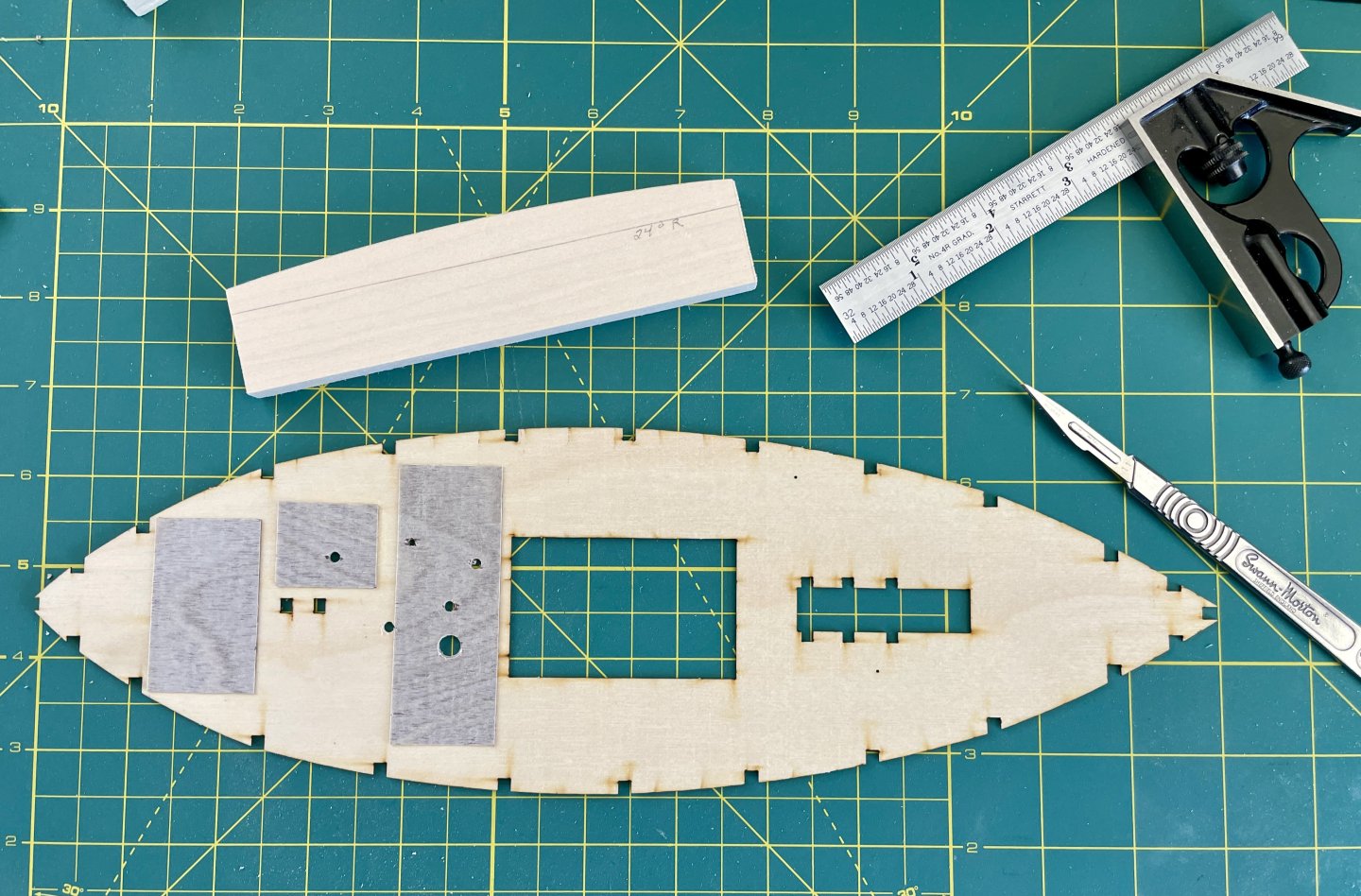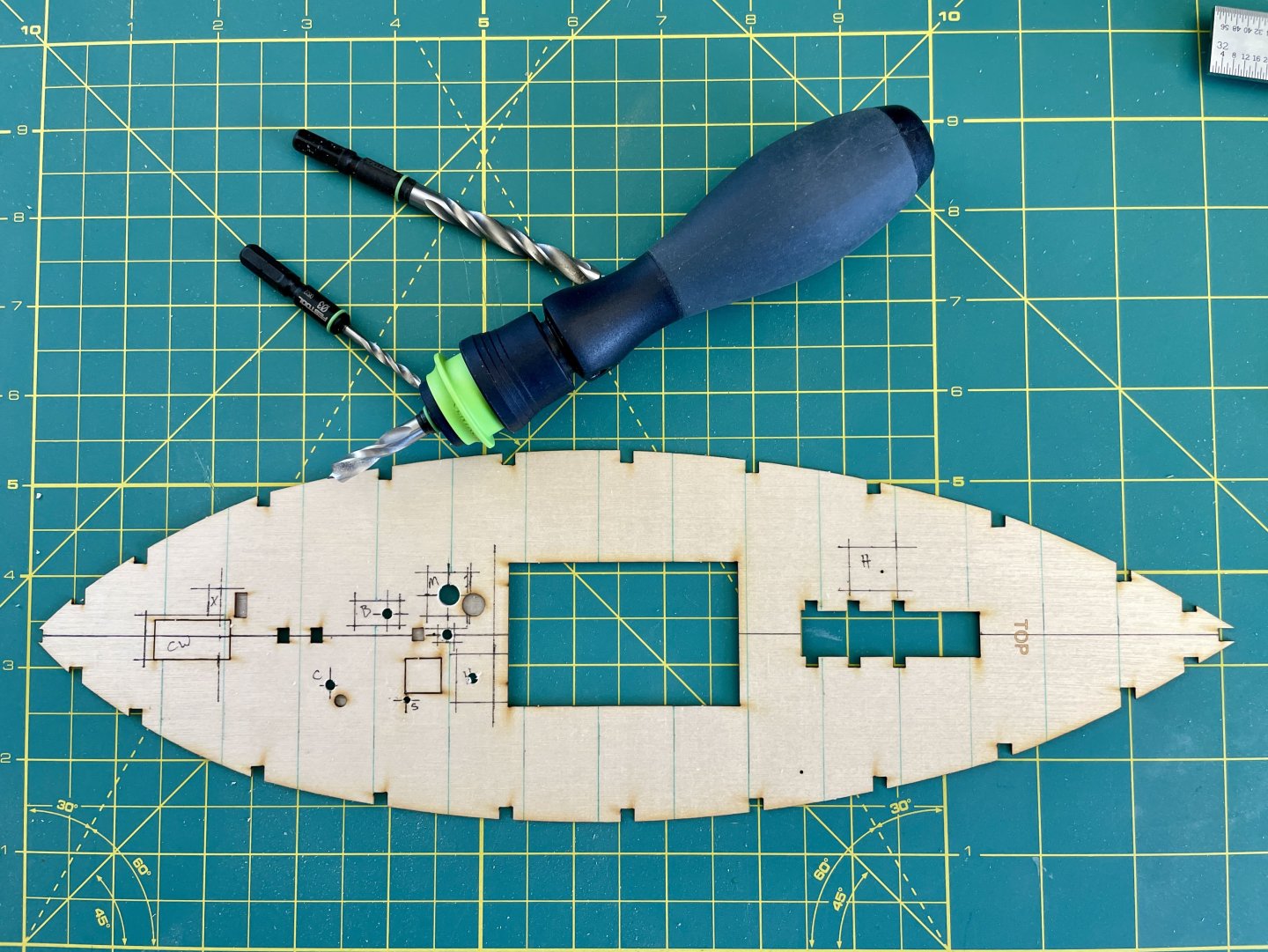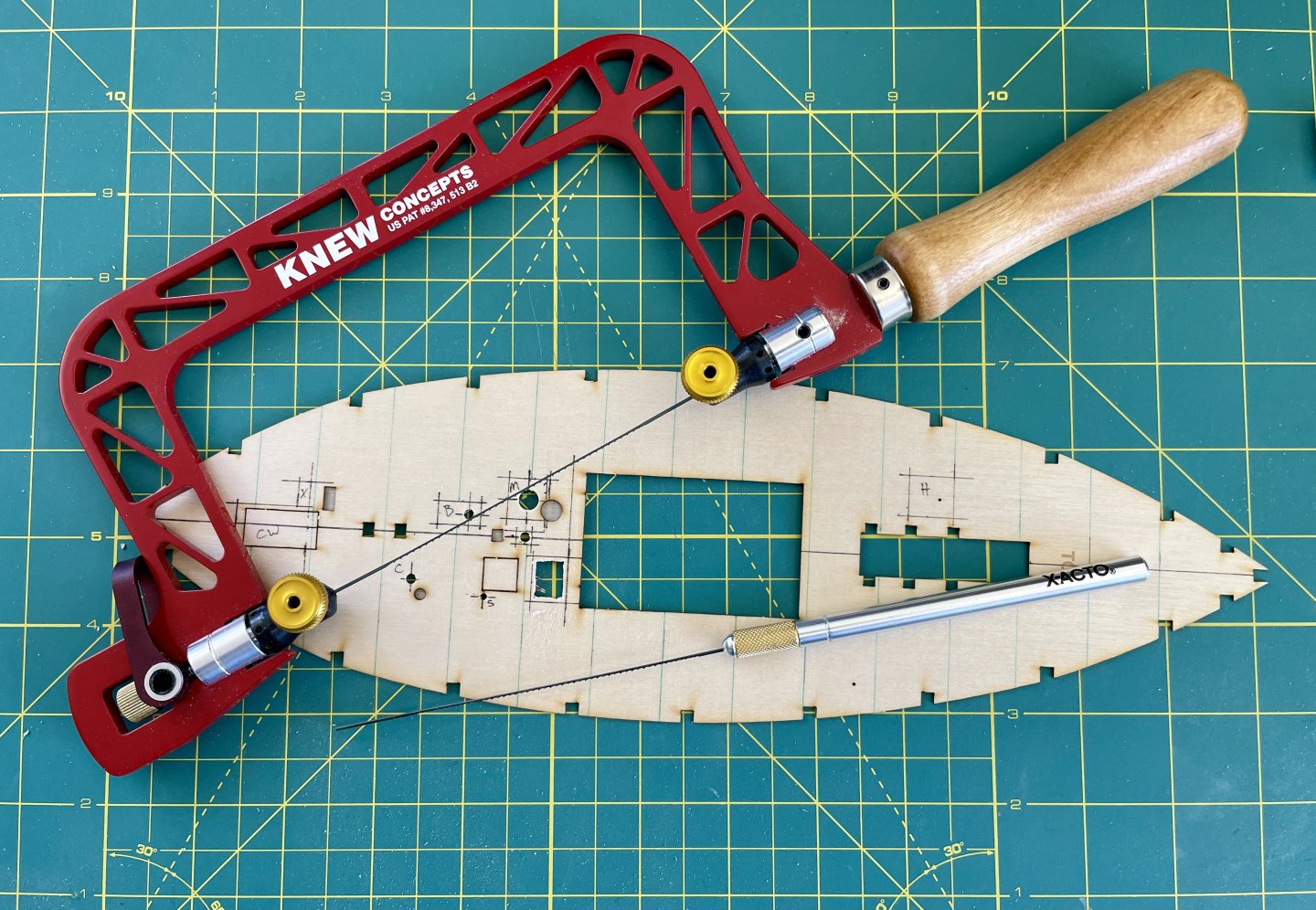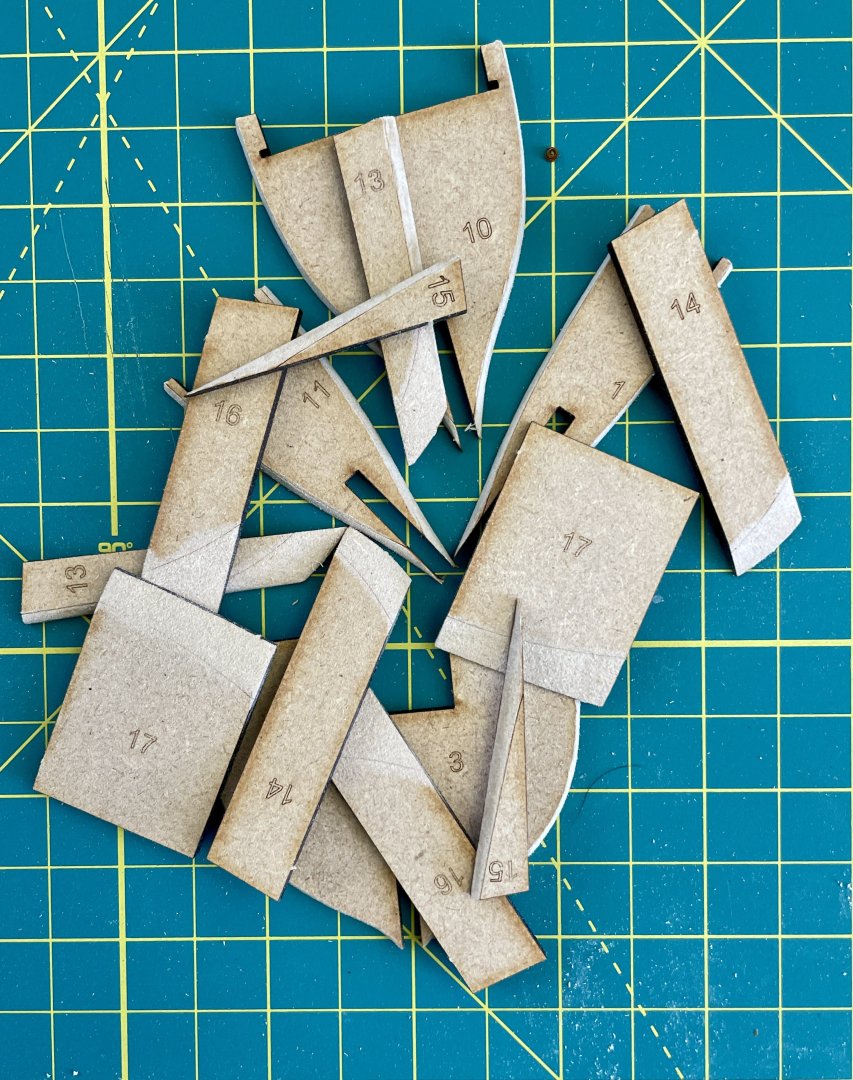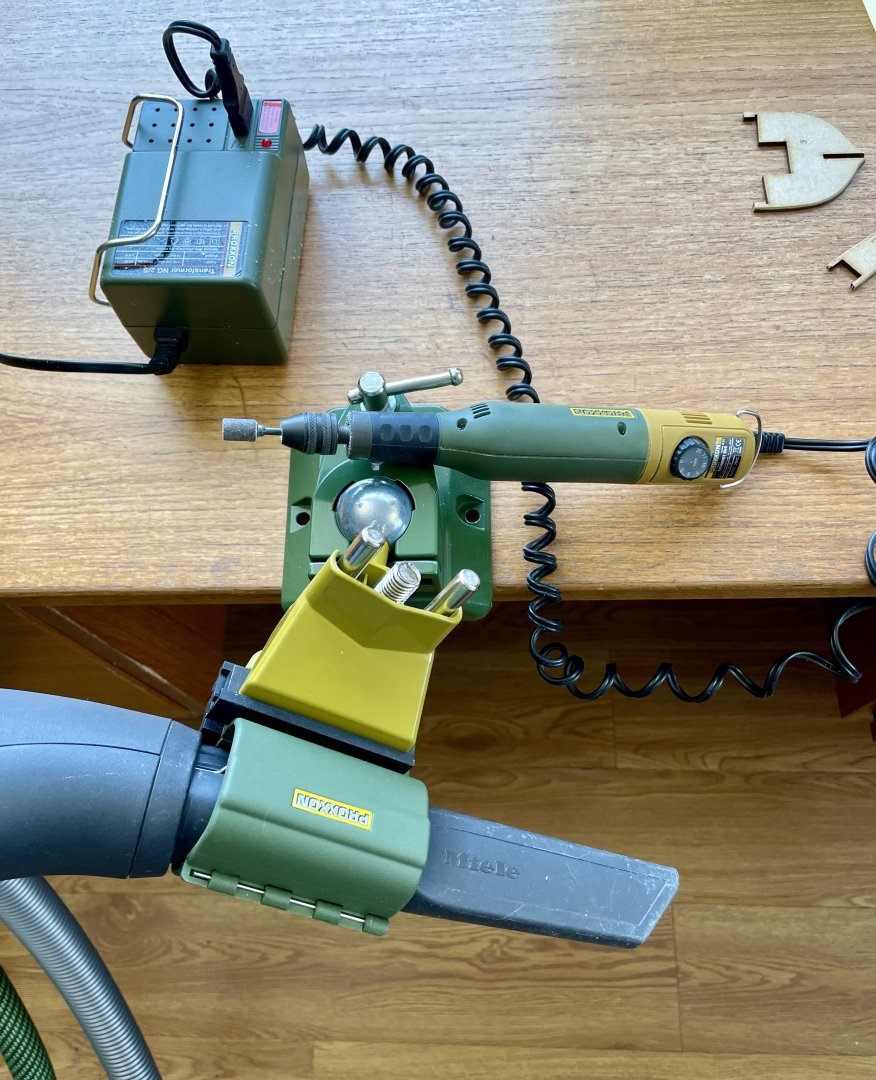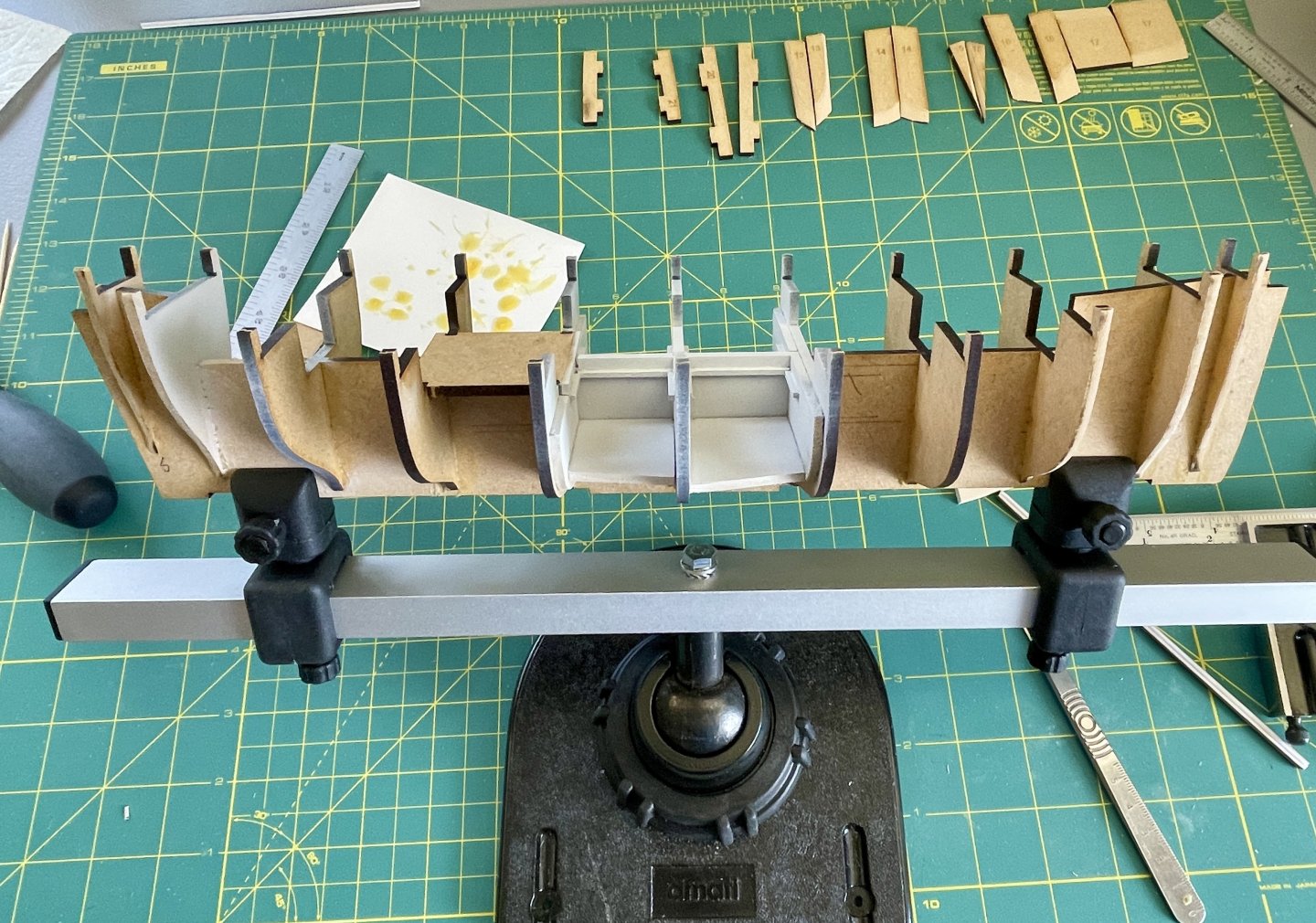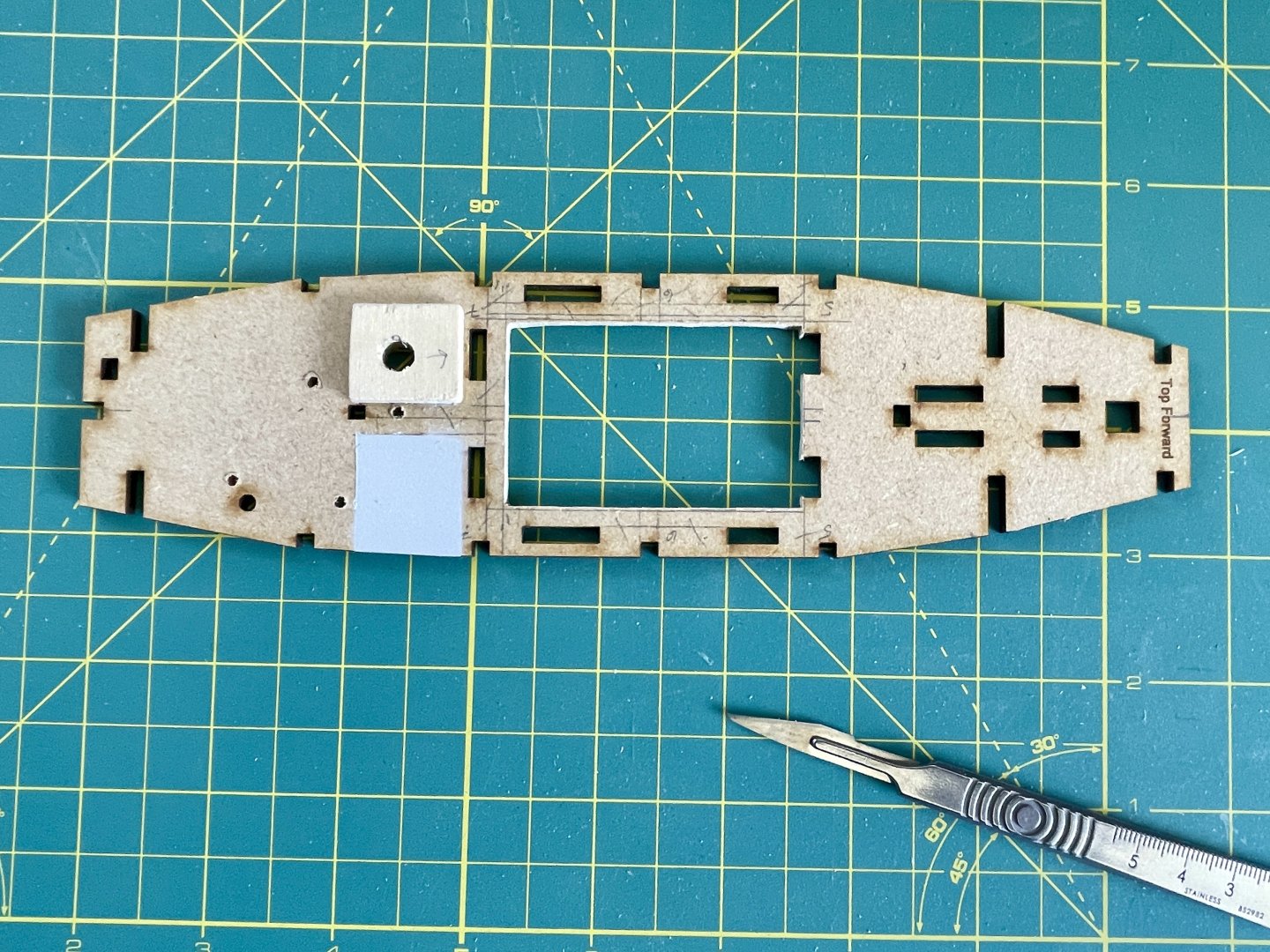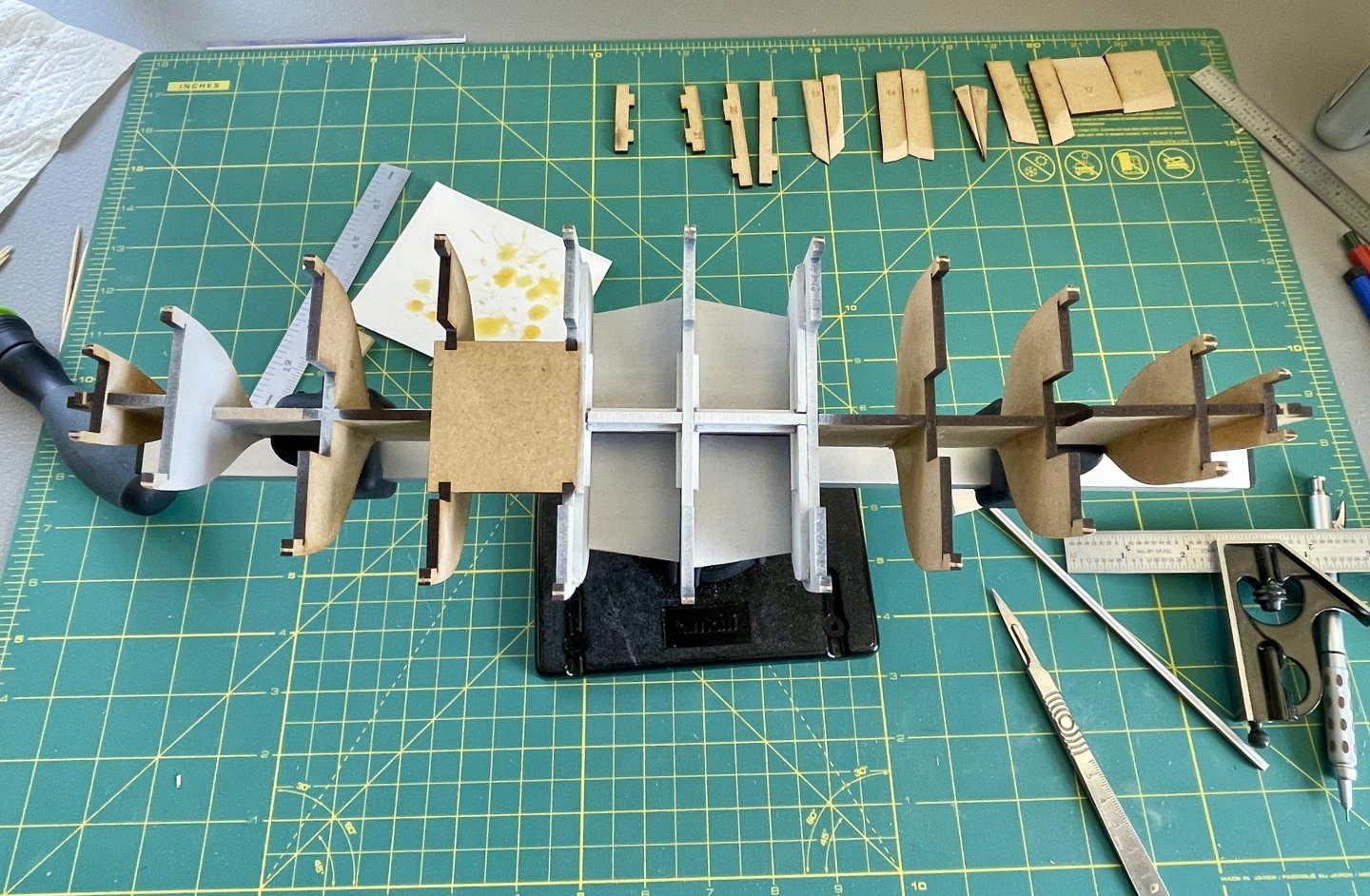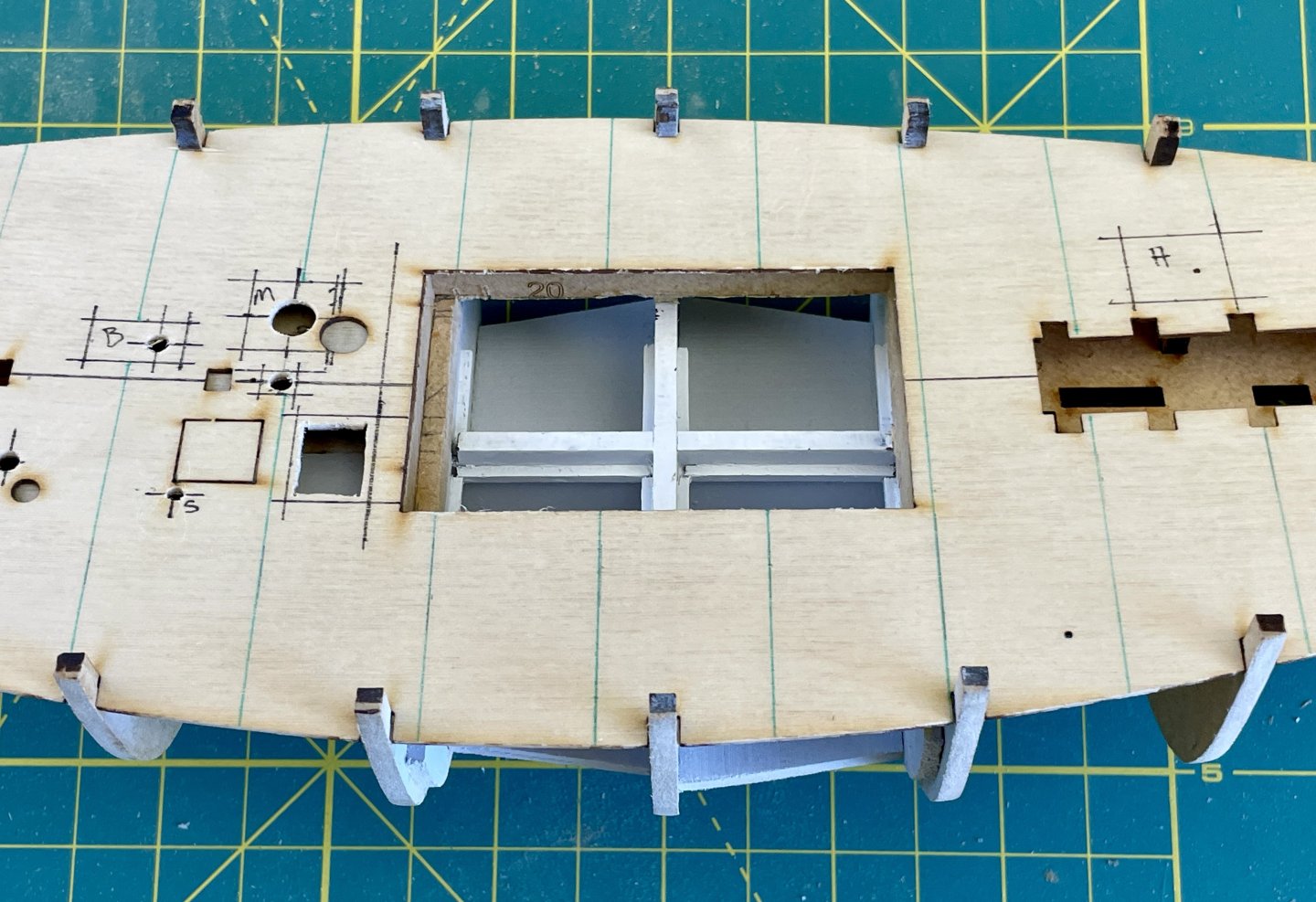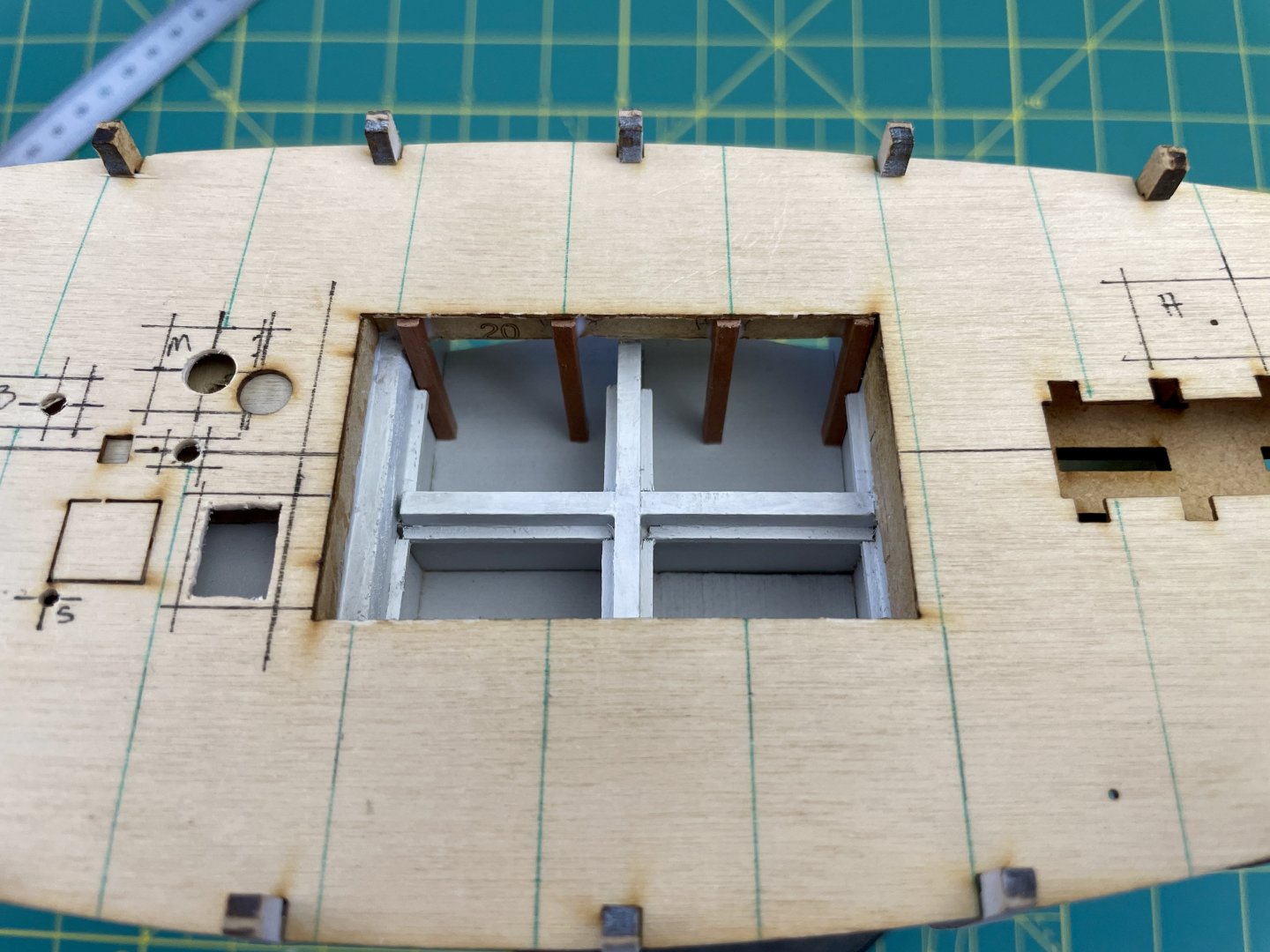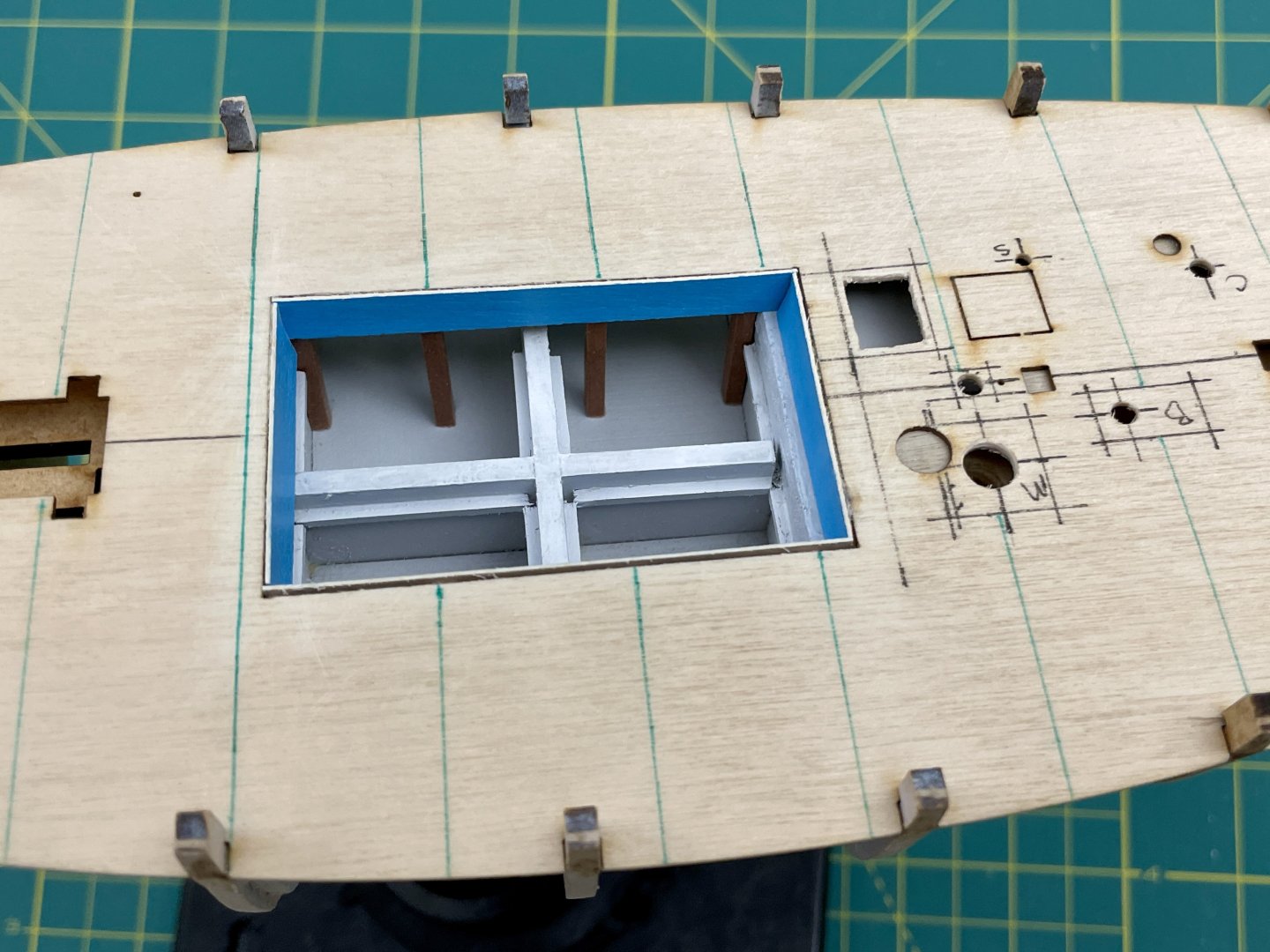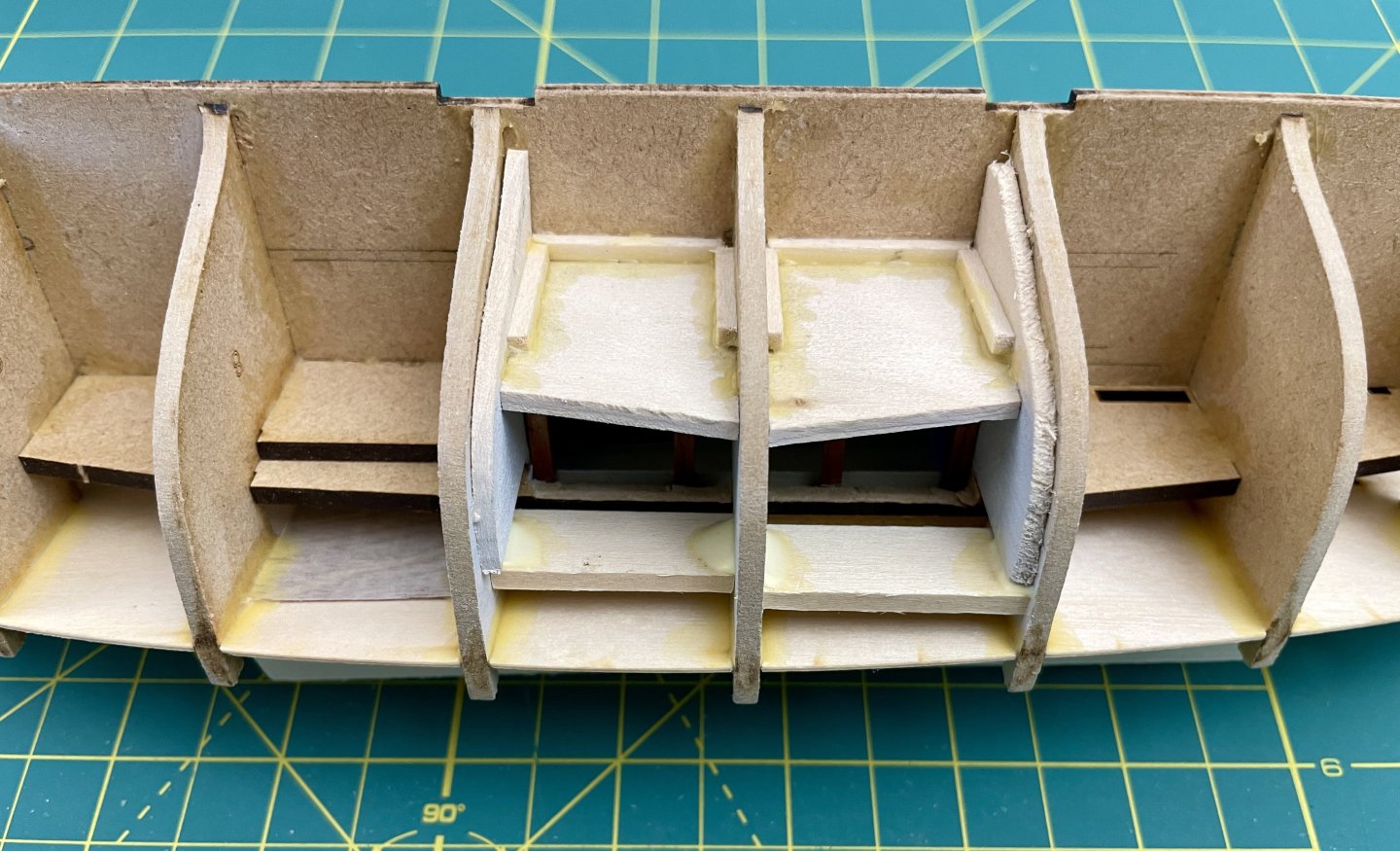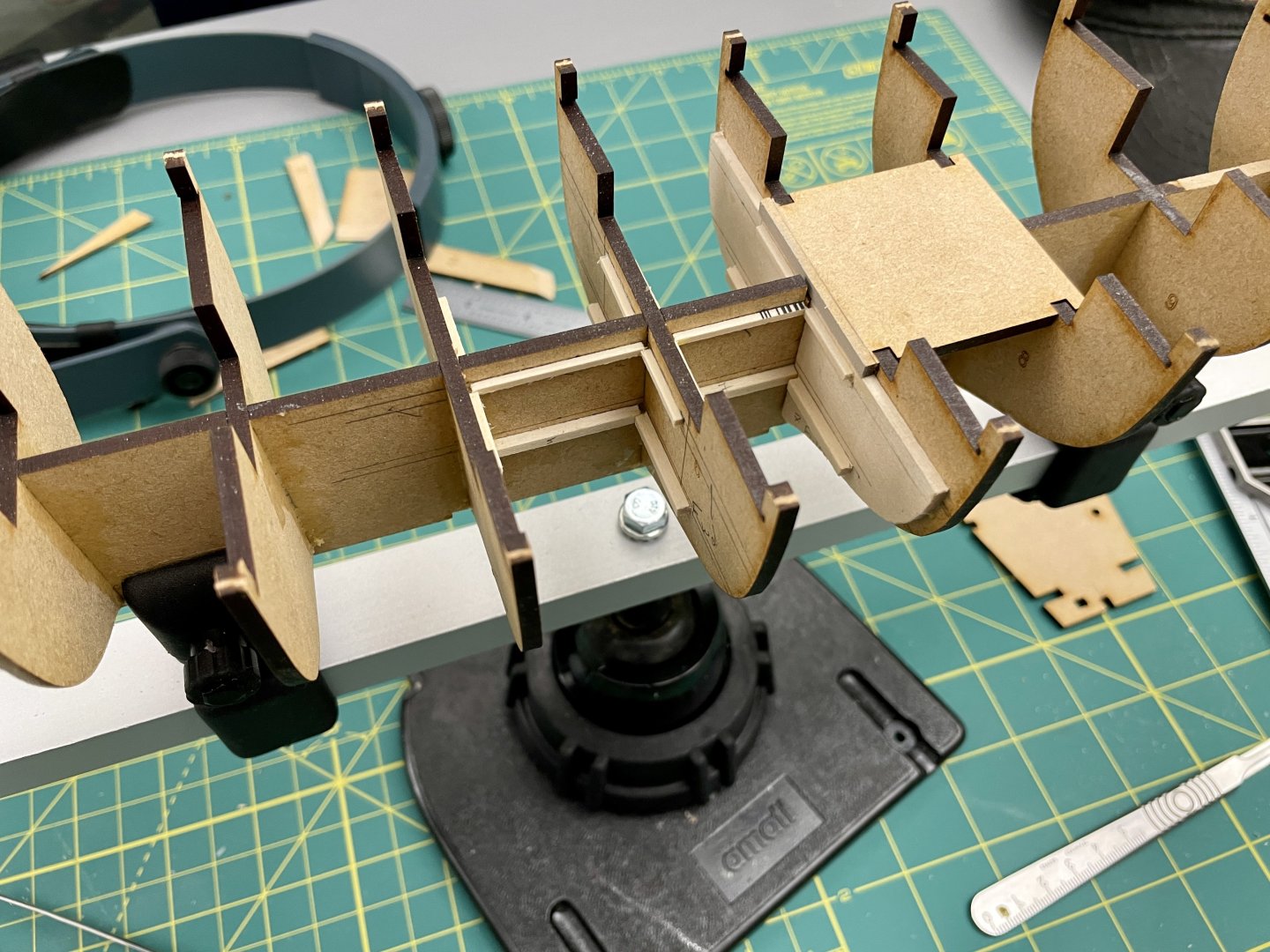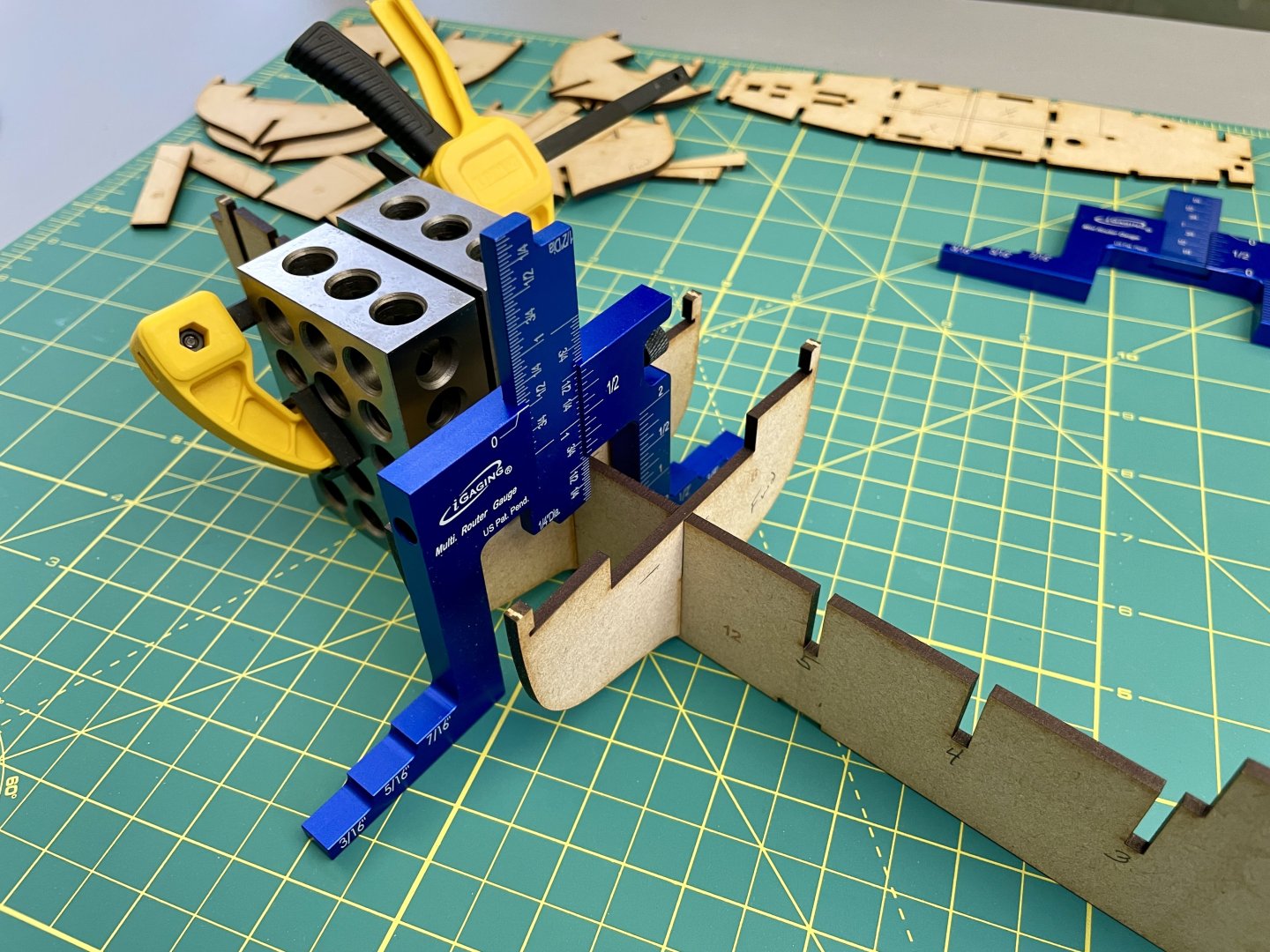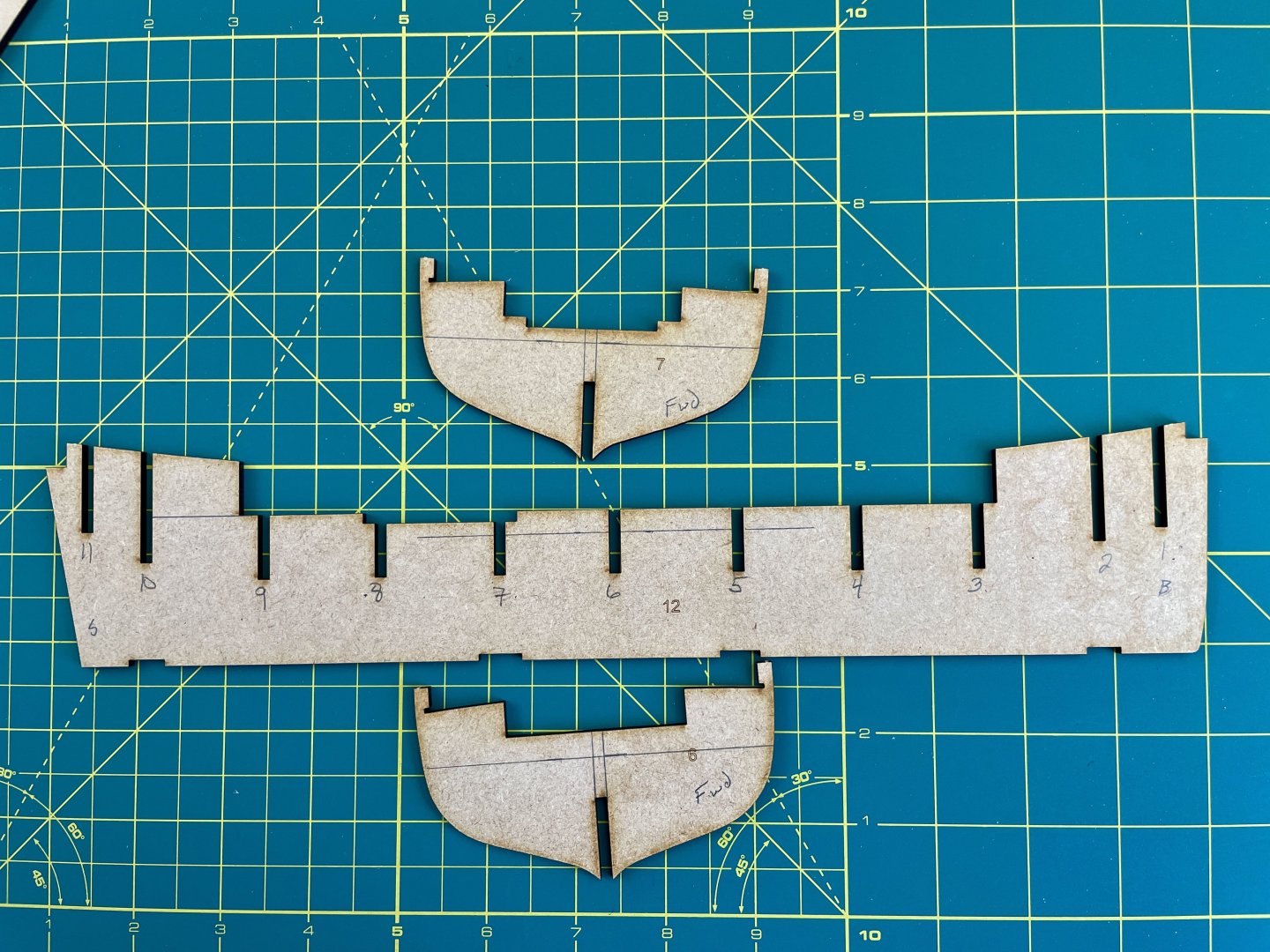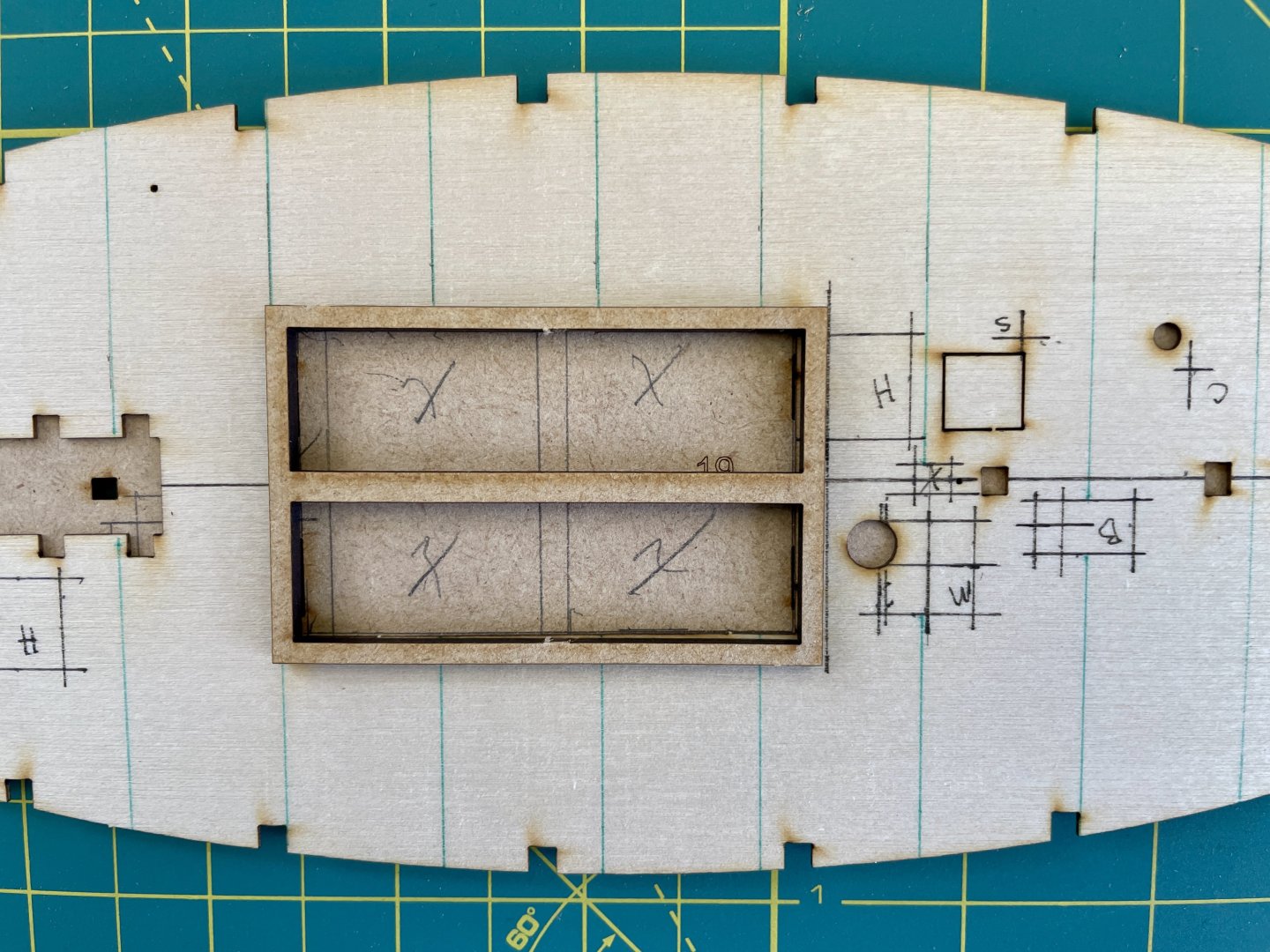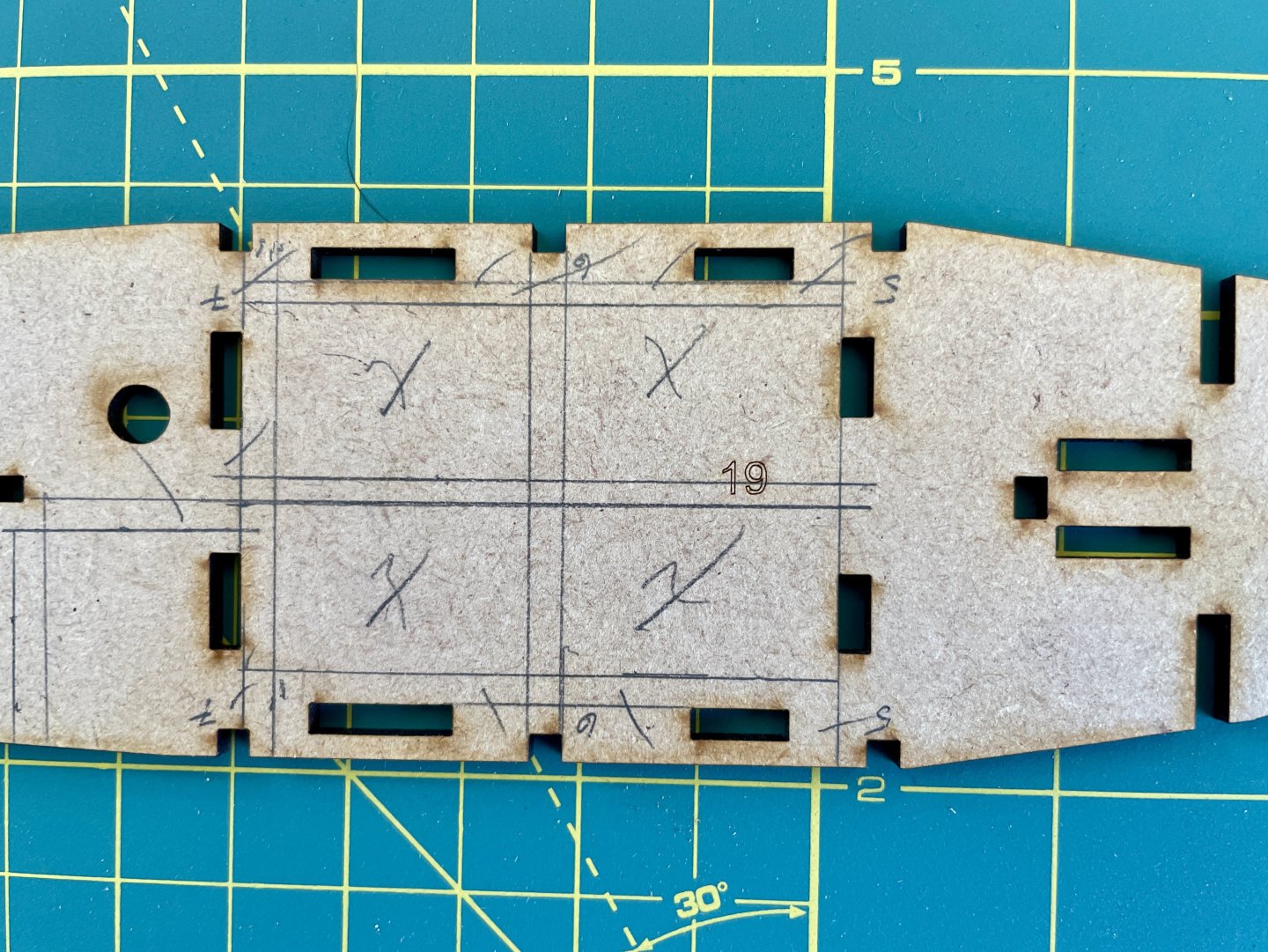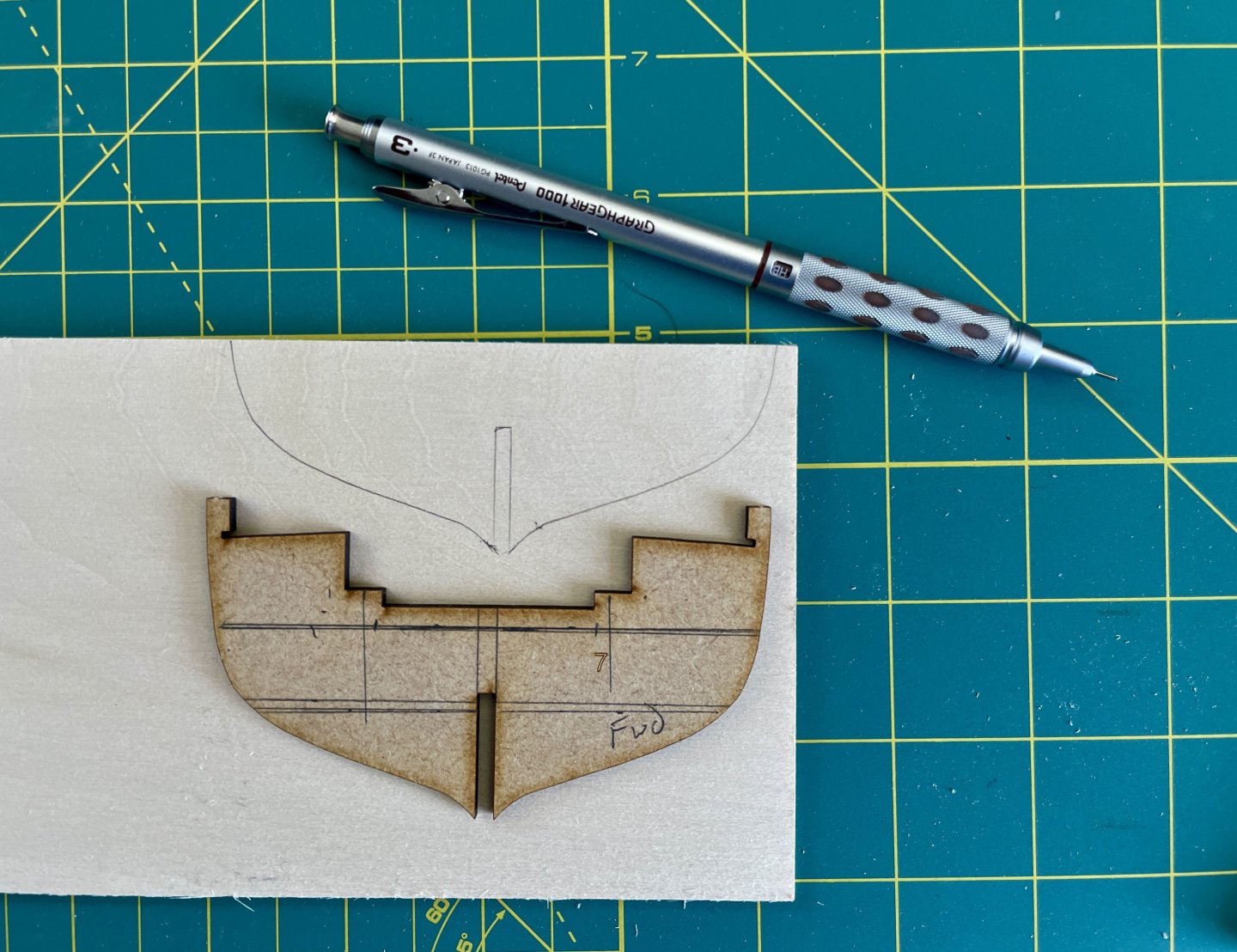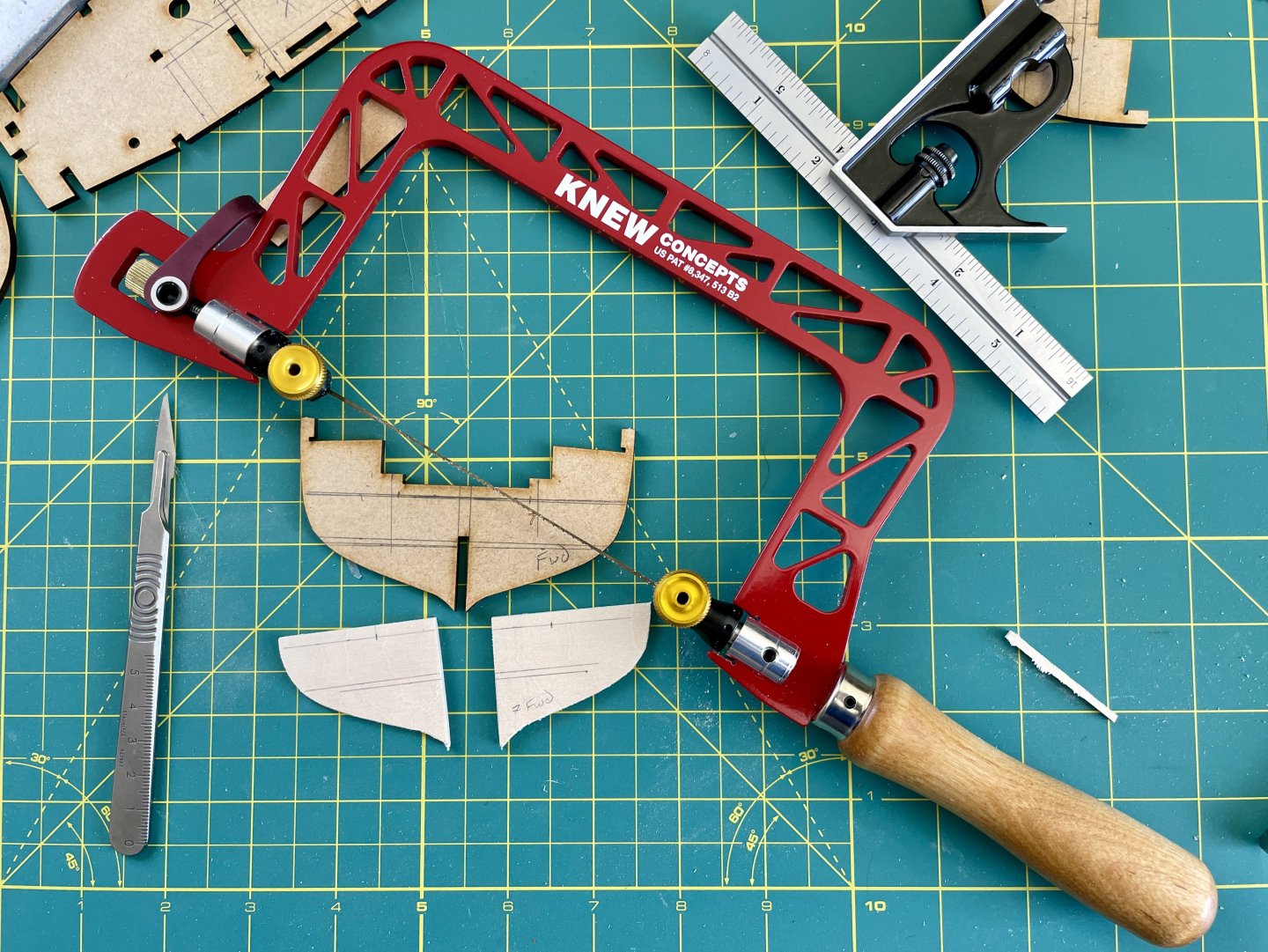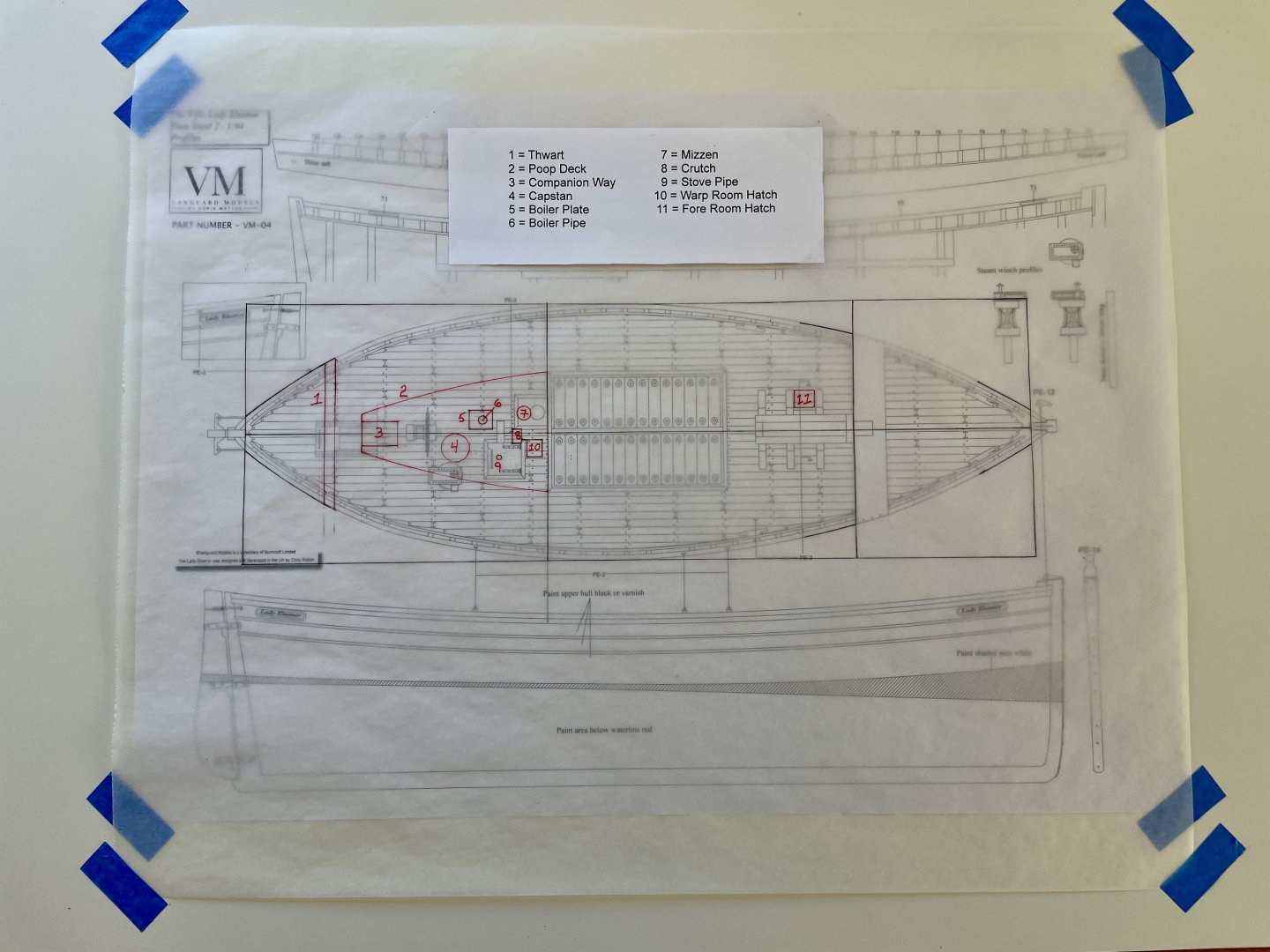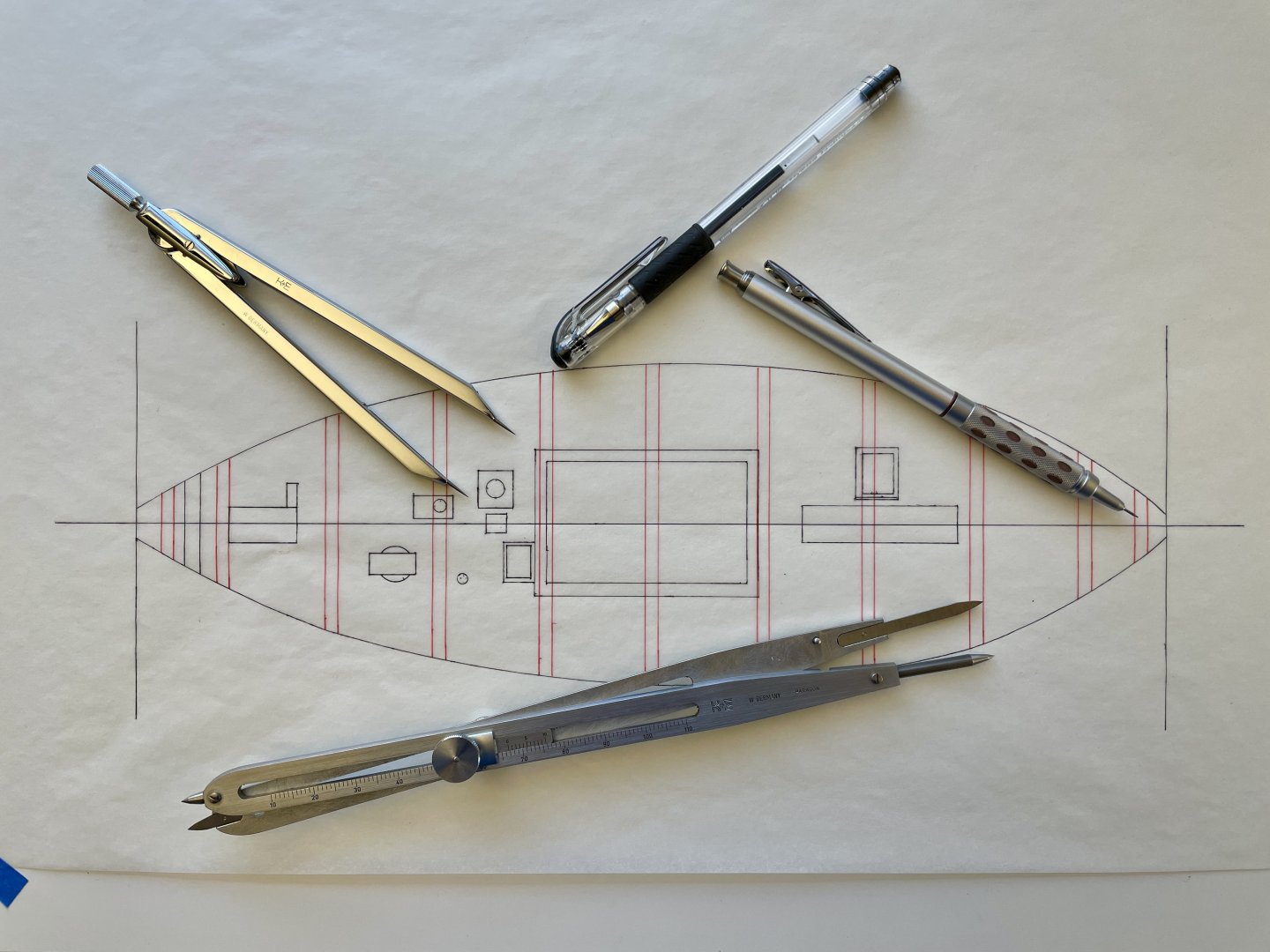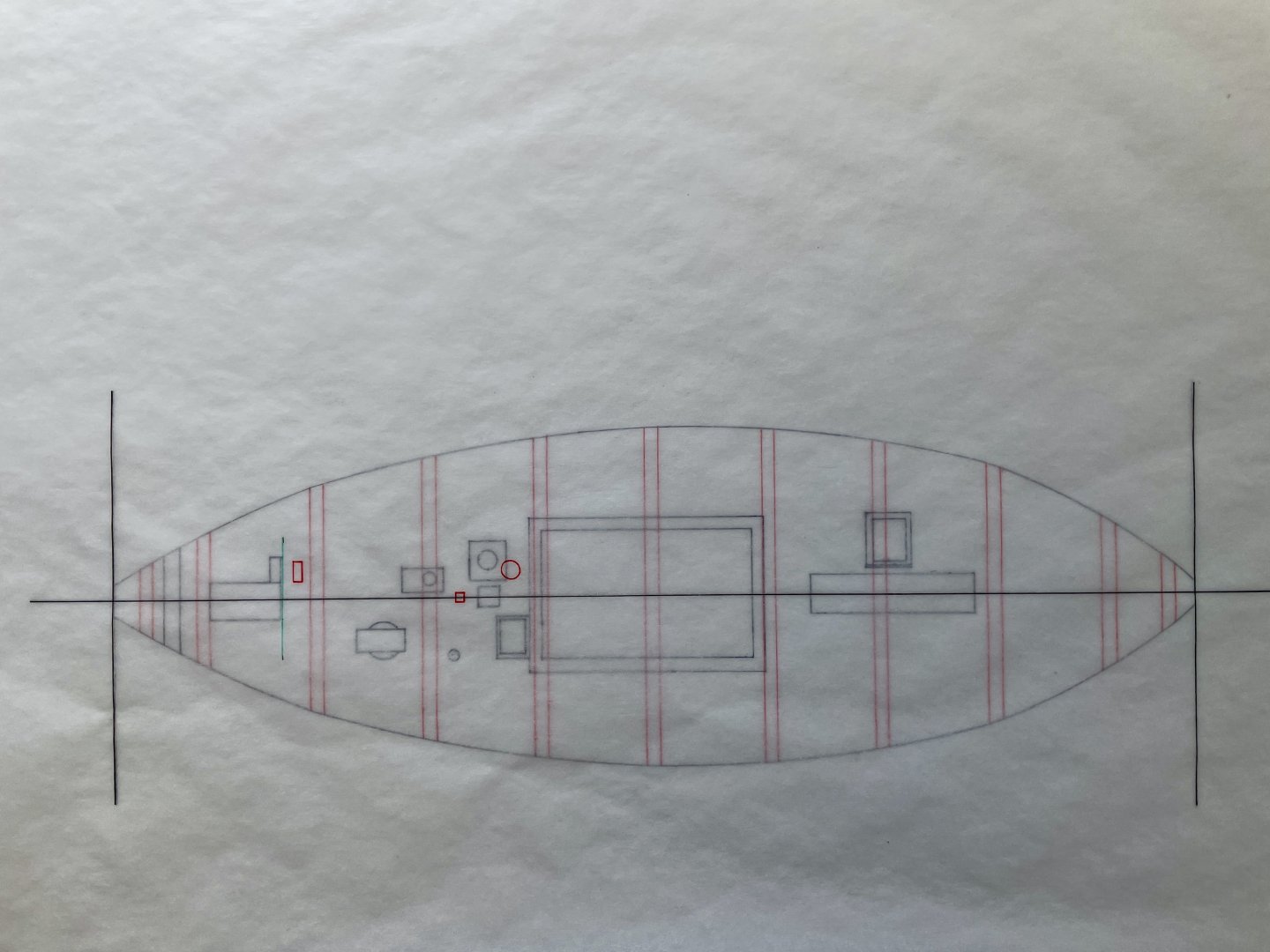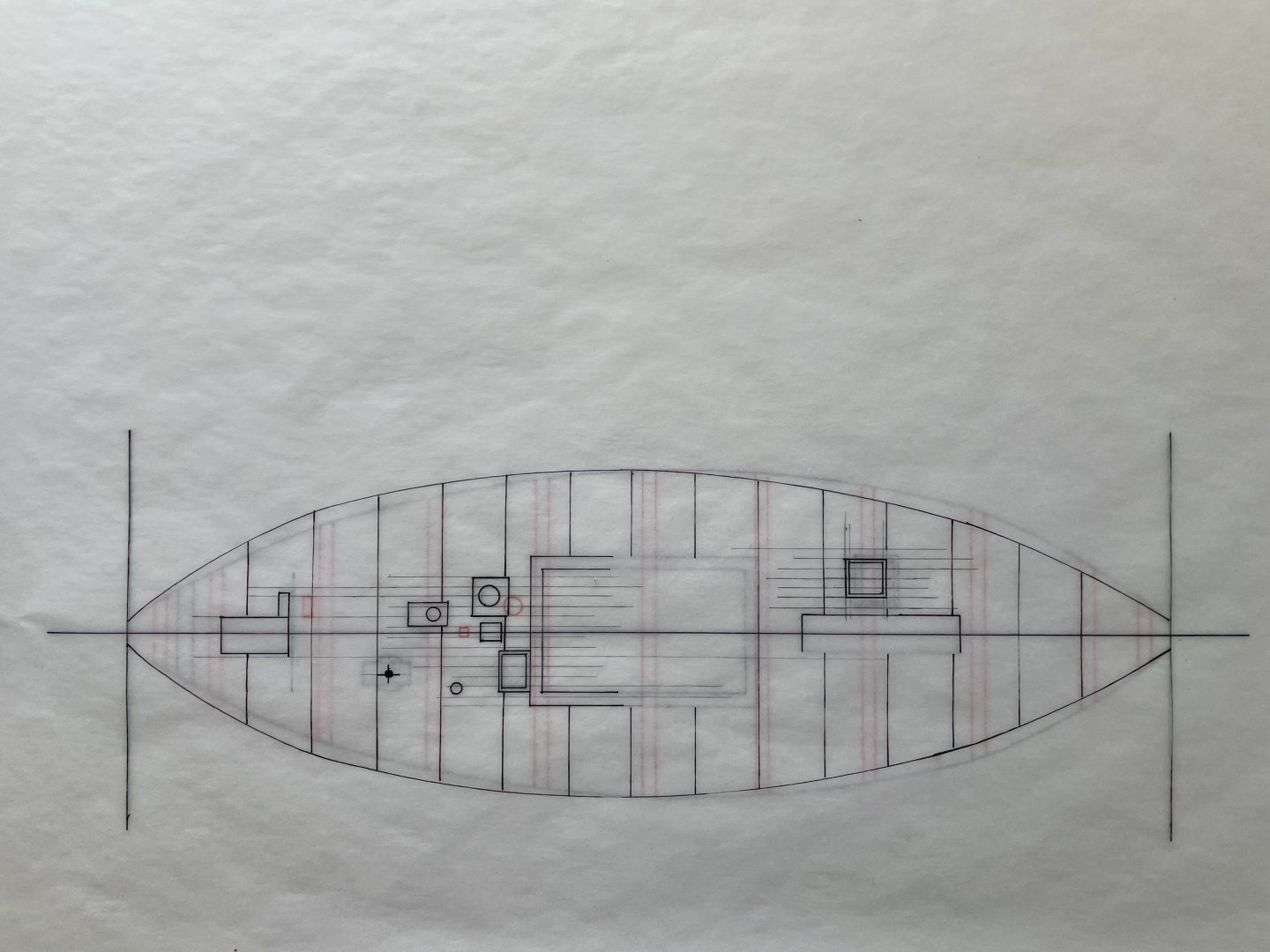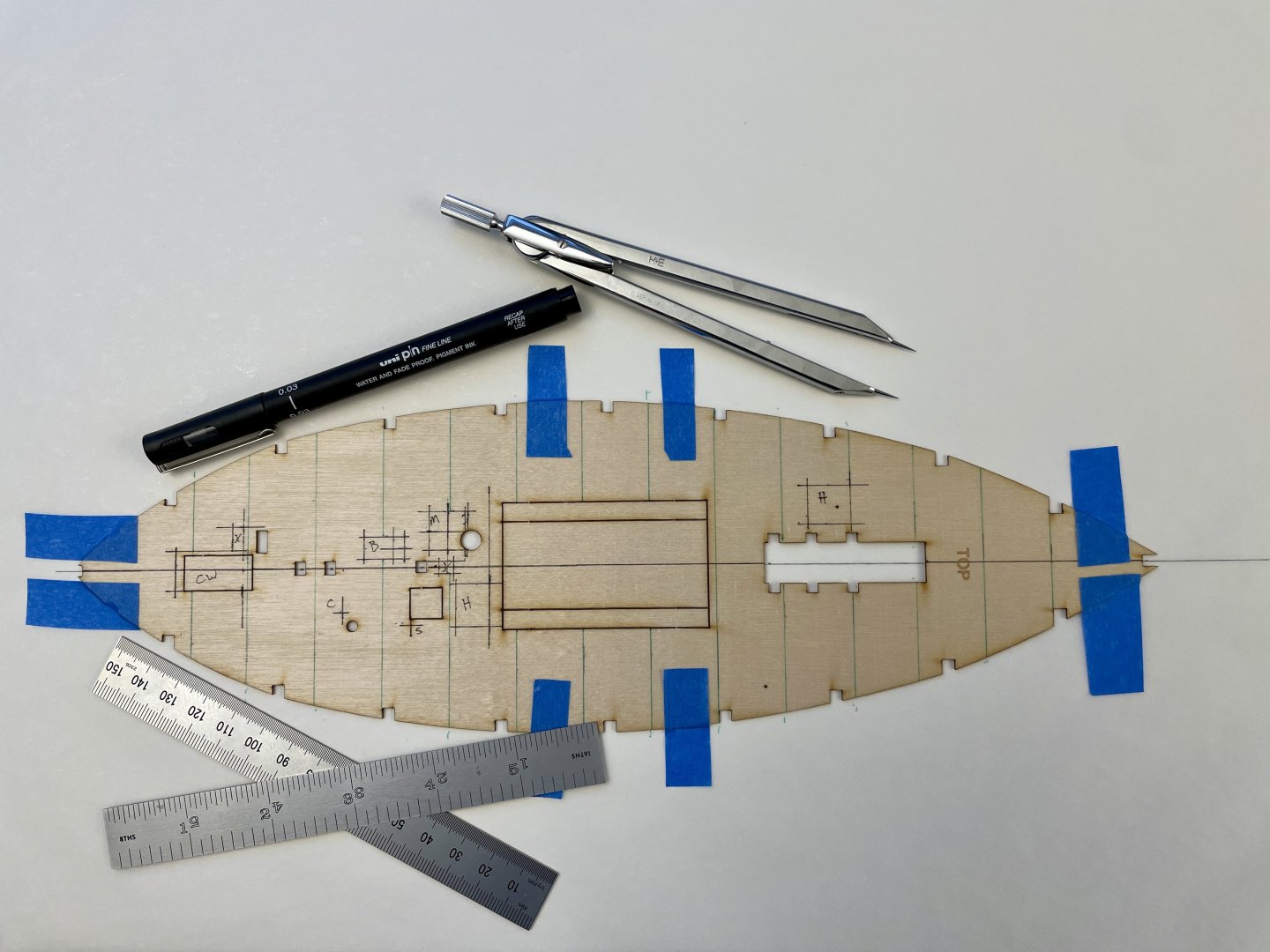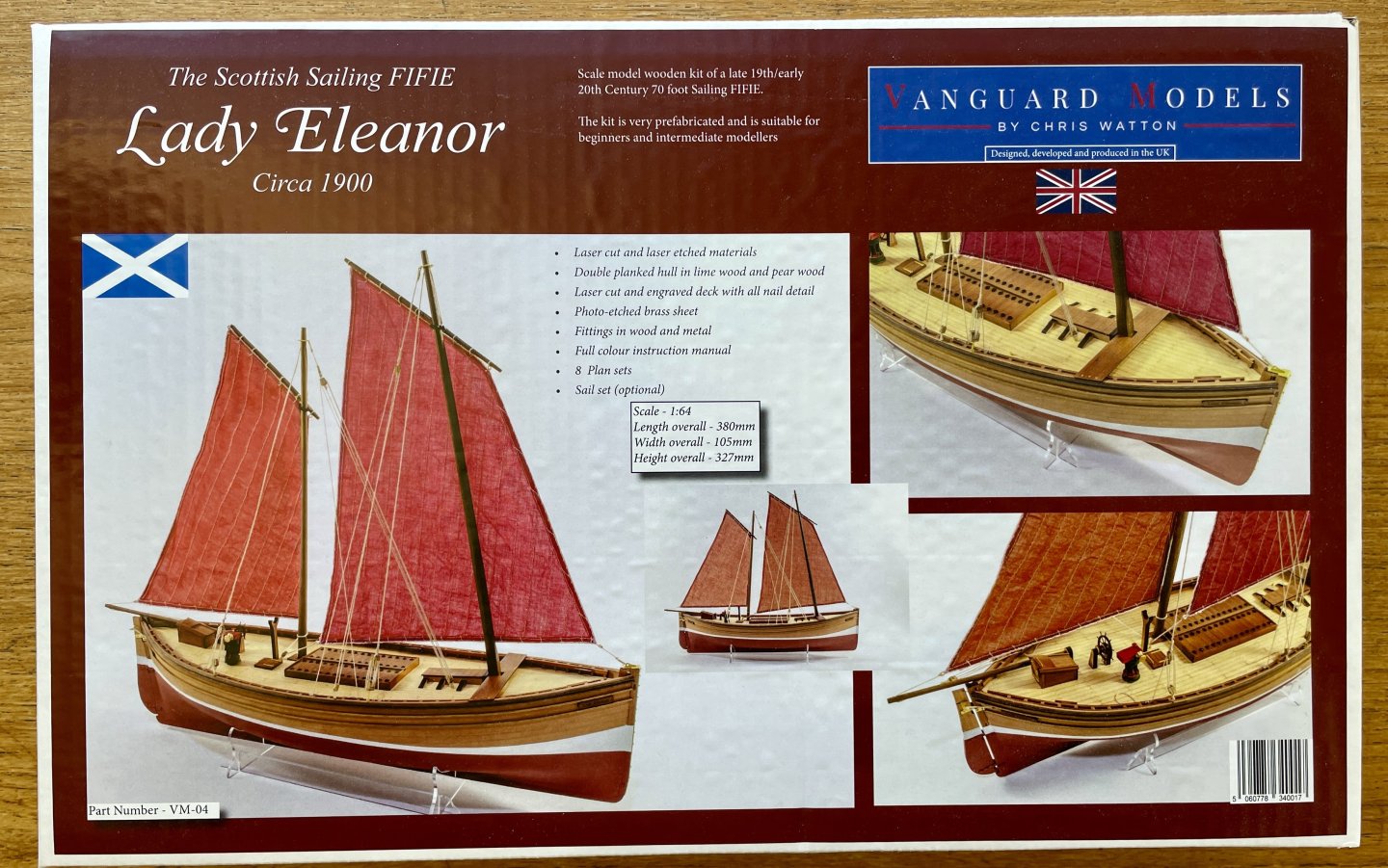-
Posts
605 -
Joined
-
Last visited
Content Type
Profiles
Forums
Gallery
Events
Everything posted by Jay 1
-
Current Build Status and Break Now that I know my modifications won’t trash the model and actually worked out okay, from this point forward, my log will reflect my where I’m actually at with my build which is installing the bulwarks and planking. Because I have a lot happening at work next week and then am on the road for work again the following week, I may not be building much, if at all, for next couple of weeks. Cheers, Jay
- 16 replies
-
- Lady Eleanor
- True Vine
-
(and 2 more)
Tagged with:
-
Subdeck Installation and Fairing The milestone with the deck layout / hull modifications was installing the subdeck. Even though I reinforced the subdeck with birch plywood, I still didn’t know if the subdeck would or would not split from all the modifications I made to it. Additionally if the subdeck didn’t split, I also didn’t know if it would be able to bend enough into its BH positions due to its added reinforcement. I knew pre-shaping the birch plywood strips would help with bending but still the ply was additional layer of wood that would decrease the subdeck’s flexibility. Overall, fairing went well. The only real issue I encountered was with BH 1. While a batten ran fair from the bow infill piece, atop the upper sections of BH 1, and back to BH 4, the same batten didn’t touch the lower sections of BH 1 but did run fair from the bow infill piece to BH 4. I think reason behind this issue was operator error when I beveled the port and starboard lower sections of BH 1: Either my bevel angle was wrong or I just simply took off too much MDF. At any rate, I shimmed the lower sections of BH1 and made adjustments until I got fair batten runs from the bow to BH 4. Cheers, Jay
- 16 replies
-
- Lady Eleanor
- True Vine
-
(and 2 more)
Tagged with:
-
Deck Layout / Hull Modifications Pt 3 I plan on having the entryway to the companionway open; thus, the details that follow should hopefully be visible to a viewer. Some may notice I didn’t make a companionway cutout on the subdeck. The reason for this is the companionway’s position is dependent on the positions of an aft steering assembly and thwart. After I determine those item’s 2 positions, I’ll then make a subdeck cutout for the companionway. I took dimensions off the aft end of part 19 between BHs 9 and 10 and used those dimensions to make a cardstock template. I then traced the cardstock template outline onto a piece of birch plywood and then planked over the plywood with boxwood deck strips. After scraping and clear coating (matte), I then glued the boxwood planking to the aft end of part 19. Cheers, Jay
- 16 replies
-
- Lady Eleanor
- True Vine
-
(and 2 more)
Tagged with:
-
Deck Layout / Hull Modifications Pt 2 Before I glued the BHs to the false keel, I checked the camber radius of a couple BHs with radius curves. I came up with a 26 degree radius for the deck camber. I marked and cut that radius, along with also marking and cutting a 24 degree radius, in some scrap. I’ll use the 26 degree radius as a sanding template and the 24 degree radius as a bending template (the 2extra degrees is to help compensate for wood spring back). I then cut strips of thin birch plywood, wet bent it, and then let it dry on my 24 degree radius template. Once the strips were dry, I glued them over various cutouts on the underside of the subdeck. I then hand-drilled starter holes in the subdeck that corresponded to Vine’s additional fittings and alternative fittings positions. The mizzen mast hole was drilled to size. I then cut out an undersized hole where the warp room hatch will be located. Cheers, Jay
- 16 replies
-
- Lady Eleanor
- True Vine
-
(and 2 more)
Tagged with:
-
Deck Layout / Hull Modifications Pt 1 The purposes of my deck layout and hull modifications were to accommodate the Vine’s additional fittings, alternative fittings positions, and the fish hold’s alterations. I first beveled all the BHs and infill pieces with my Proxxon rotary tool (on its slowest speed). I cobbled together a makeshift dust extractor while I did my beveling (finally found a use for Proxxon’s rotary tool holder….lol). I then cutoff a top portion of the false keel between BHs 9 and 10 (more on this in Hull Mods Pt 3 below), and then glued all the BHs to the false keel. Parts 18 and 19 were then glued into place. You can see in image below where the warp room area was painted on part 19. Cheers, Jay
- 16 replies
-
- Lady Eleanor
- True Vine
-
(and 2 more)
Tagged with:
-
Fish Hold Modifications Pt 3 I then painted the fish hold area, and also BHs 9 and 10, light grey (Mr. Color 97). I used light grey because white paint usually looks grey in dim lighting. I painted the top edges of the fish hold flat white (Mr. Color 62) because those areas would receive more direct light than the hold further below. As mentioned earlier, the fish hold and deck layout / hull modifications were done in tandem so what follows next will appear like I’ve skipped a few things; however, those gaps are covered in my deck layout / hull modification posts. After the subdeck was installed, I undercut part 19’s MDF until it wasn’t fully visible below the two part 20 pieces. I then installed 8 3mm shellacked pearwood stanchions in the fish hold. The fore and aft stanchions on each side of the hold don’t fall under green deck beam lines because that’s where BHs 5 and 7 are located. I then installed painted veneer (Mr. Color 323) on all 4 sides of the fish hold and then sanded the tops of the veneer flush with the subdeck. The last item of the fish hold modification was installing bracing blocks to additionally compensate for the cutout I made in part 19. Successfully completing the fish hold modifications without trashing the integrity of the model was a milestone! Cheers, Jay
- 16 replies
-
- Lady Eleanor
- True Vine
-
(and 2 more)
Tagged with:
-
Fish Hold Modifications Pt 2 I then hand-drilled starter holes into part 19 that correspond to Vine’s subdeck additional fittings and alternative fittings positions. While not visible, I reinforced the underside of part 19 at its original mizzen mast hole before I hand drilled the mizzen mast’s new position. I also reinforced the top of the new mizzen mast hole with an additional drilled support. Both holes are slightly ovoidal fore and aft to allow for raking the mizzen mast when it’s installed. The pencil lined ½ square starboard of the mizzen mast support is about where the warp room hatch will open to, so this area will be painted. I then used a fret saw to cut out the X’d areas of part 19 to deepen the fish hold. I left about a 1/4 inch / ~ 6mm of meat on the port and starboard sides of part 19 to help keep it from possibly breaking. I then began added the upper and lower supports framing to BHs 5, 6, 7, and the false keel; I also glued bracing inserts atop the lower framing supports. Cheers, Jay
- 16 replies
-
- Lady Eleanor
- True Vine
-
(and 2 more)
Tagged with:
-
Fish Hold Modifications Pt 1 My purpose for modifying the fish hold depth was to add interesting detail to the model. I began the fish hold modifications by using a height gage to mark positions for fish net platform supports. Because I didn’t have a sense of the model’s rigidity and etc. at this point, I didn’t want to alter bulkhead (BH) 6 or the false keel to the point where I would potentially compromise the hull form or structural integrity of the kit. My decision on the heights of the net platform supports was a balance of getting a net to fit in the hold, hide the false keel and BH 6, and yet also be able to position the net so portions of the hold depth and etc. are visible. These platform supports largely won’t be visible, esp. along the false keel, once netting is added to the hold. I then laid the fish hold frame (part 22) on top of the subdeck that in turn was laid over part 19 (it’s kind of sub-subdeck). The purpose here was to mark where I would make my initial cut outs in part 19 to deepen the fish hold. I then marked positions for lower supports onto BHs 5, 6, and 7. The purpose for these lower supports is hold bracing inserts that should help compensate for the weakening of part 19 due to its cutouts. The bracing inserts will also serve as platforms onto which stanchions will be glued. I also traced the outlines of BHs 5 and 7 onto basswood and then cut out those traced BHs. These BH cutouts were then glued to BHs 5 and 7 so that the fore and aft sides of the fish hold aligned with the fish hold subdeck cutout. Cheers, Jay
- 16 replies
-
- Lady Eleanor
- True Vine
-
(and 2 more)
Tagged with:
-
Fish Hold and Deck Layout / Hull Modifications I decided to not post my log until after I successfully completed modifications I made to the fish hold and deck layout / hull. Clearly since I’m posting my log now, everything turned out okay but I didn’t know that when I started building. Essentially I didn’t want to start a log and then abandon both it and the build because my mods turned out to be trainwrecks! The next several posts describe the mods I made, and although I’m posting the fish hold and then deck layout / hull mods separately, all the modifications I made had to be done in tandem with one another and progression of the build. Cheers, Jay
- 16 replies
-
- Lady Eleanor
- True Vine
-
(and 2 more)
Tagged with:
-
Build Adaptations I mentioned in my comparison of the RMG and Beale “True Vine” models above that my intent was not to be critical of either build; indeed, I have no room to throw stones at either model since my model will also deviate from Oke and Marsh’s Vine plans. To see how much I could adapt the Vine to Eleanor, I 1st prepared the below quick-and-dirty overlay of the Vine’s key features onto Elanor’s deck plan. This was relatively painless using a pair of proportional dividers because the Vine’s scale is 1:32 (3/8” to the foot) and Eleanor’s scale is 1:64 (3/16” to the foot) and thus works out to a straightforward 1:2 ratio. A feature of the Vine that I went back and forth over during my research is her poop deck. Ultimately what persuaded me to not include it were a passage from Marsh, contemporary photos, and finally what was esthetically appealing to my eye. When Oke took off the Vine’s lines in 1936, she had already had undergone considerable alterations to include having been fitted with a motor (Marsh, “Drifters” 271). Marsh infers the poop deck may have been fitted onto the Vine after she had a wheelhouse fitted, along with other major alterations, when her motor was installed well after she was built in 1905 (“Drifters” 271). Although a poop deck / deck superstructure is a common feature of Zulus, I found no similar examples on any Fifies during my research. Indeed, the Vine’s poop deck is strikingly similar to the circa 1905 Zulu that Marsh discusses on page 265 and also provides a photo of (“Drifters” plate 173). After reaching my decision about Vine’s poop deck, I then created a series of drawing layers (an old school version of Photoshop…LOL) using the kit’s plain subdeck . The purpose of the 1st layer drawing was to get a sense of where the Vine’s deck fittings were in relationship to Eleanor’s fittings and to also get a sense for how additional modifications that I want to make will align with respect to Eleanor’s keel and bulkhead framing. In case someone’s reading this, I inked in the wrong lines of the fore room hatch on this layer, so it’s proportions are a wee bit off…. The purpose of the 2nd layer was to see were and how changes I’ll make will impact part 19 in the kit, which I’ll go into when I start building. The purpose of the 3rd layer was to get an idea of where the Vine’s deck fittings will land with respect to the boat’s deck planking. Essentially I want to avoid having splinters for deck planks because of deck fittings placement. While I won’t 100% know how the deck planking will work in relation to deck fittings until I actually start planking the deck, I did make few slight placement changes at this stage to align with my deck plank sizes and approximately where they’ll land on the deck. Also I fixed the proportions of the fore room deck hatch on this layer. The keen observer will notice the deck outline on the 3rd layer slightly differs from the deck outline on the 1st layer…. I used the printed maple deck to draw the outlines on the 1st and 3rd layers. However, because the printed deck really curls upward, I flipped this deck over to its unprinted side to compensate for its curl. When I inked deck outline on the 1st layer, I didn’t notice I had reversed the bow and stern ends of the printed deck when I flipped it over. Although my goof didn’t impact deck fittings positions, it did give me a laugh when I caught the mistake when I started working on the 3rd layer drawing. After I finished the 3rd layer drawing, I then transferred that layer’s deck fitting positions onto the kit’s subdeck. The green lines on the subdeck mark deck beam positions taken from the kit’s printed maple deck, and I’ll use these lines as rough guides when it comes time to figure out the deck’s butt shifts. Cheers, Jay
- 16 replies
-
- Lady Eleanor
- True Vine
-
(and 2 more)
Tagged with:
-
“True Vine” Models Although I may sound critical with my assessment that follows of the RMG and Beale “True Vine” models, that’s absolutely not my intent. My intent here was only to describe how each model significantly differs from the Vine’s plans. The Royal Museums Greenwich (RMG) model of the “True Vine” in its collection and Tom Beale’s model (see Will Taylor reference entry) of her can hopefully give one a sense of her Oke and Marsh plans. Of the 2 models, Beale’s version is closer to Oke and Marsh’s plans than is the RMG version. However, the RMG lists no information about when its model was built or who its builder was, so it’s possible the RMG model was built off different plans than Oke and Marsh’s. The thwarts just aft of the midships on the RMG version are not in Oke and Marsh’s plans; also, this model version appears to not have a warp room hatch. I will discuss later in my log the nets on model’s port side. Source: RMG, www.rmg.co.uk/collections/objects/rmgc-object-68796. Beale’s worm drive mechanism at the stern of his model doesn’t align with the Vine’s plans. I’ll go into more detail about the Vine’s worm drive when I reach that point in my build. Also while the knees on the starboard side of the tabernacle on Beale’s model are not in Oke and Marsh’s plans, I think their addition by Beale was a misinterpretation of Marsh. In “Sailing Drifters” page 271, Marsh describes the Vine’s foremast as being stepped into a tabernacle with “side bridges.” Earlier on page 249, Marsh discusses the “Gratitude” and describes how its foremast is also stepped into a tabernacle with “bridges.” However in addition to his description, Marsh also includes a drawing of the foremast tabernacle (figure 64) that is without knees and then further directs the reader to plate 152, which is a photograph of the forward end of the “Gratitude” and clearly shows the vessel’s tabernacle which does not have knees. Until I read page 249 and studied the accompanying figure and plate, I was also thrown by Marsh’s term “side bridges” and thought he may have meant knees but was confused because there aren’t any tabernacle knees depicted in the Vine plans. After I read page 249, and then looked back again at Vine’s plans, it became clear to me that Marsh’s “side bridges” term referred to a tabernacle’s framing versus being his term for tabernacle knee braces. Beale’s choice to depict the Vine with sails set and nets draped from the mainmast while in drydock is interesting but likely was a stylistic choice—no stone throwing there because I’m going to include a few stylistic embellishments in my build, too. Cheers, Jay
- 16 replies
-
- Lady Eleanor
- True Vine
-
(and 2 more)
Tagged with:
-
Notes & References Notes I’ll update my log reference list below as needed throughout my build. For those considering building either Chris’ Fifie and or Zulu kits, or both kits, Marsh’s “Sailing Drifters” is an invaluable resource. The SS Great Britain Trust holds the David McGregor ship plans collection; however, they do not have copy right permissions for Oke and Marsh’s “True Vine” plans, which are part of the McGregor collection, and thus cannot sell copies of those plans. While fair dealing and fair use guidelines do allow for the use of copyrighted material for educational and scholastic purposes, applying those guidelines can be tricky. Given that the plan copy right permissions for the “True Vine” are in question, and the plans in Marsh’s “Sailing Drifters” are definitely copyrighted, I decided it was prudent to not post plan images on MSW. Gordon Williams’ model of the “Muirneag” is an excellent source of detail from whom MSW’s Blue Ensign (BE, i.e., Maurice Wilcox below), and I have borrowed inspiration. Likewise, I have also borrowed inspiration from BE’s excellent “Lady Eleanor” and “Muirneag” builds. The Scottish Fisheries Museum’s Fifie “Reaper” is an great source and resource. Also the surviving Fifie “Swan,” though not as well-known as the “Reaper,” is also a first-rate resource, though I did find fewer images of her than of “Reaper” during my web research. References “Cellardyke Sailing Fishing Boats.” The Cellardyke Trust, 15 Sept. 2023, www.cellardyketrust.org/further-cellardyke-research/cellardyke-photos/cellardyke-sailing-drifters/. “Collections.” SS Great Britain, 7 Feb. 2024, www.ssgreatbritain.org/collections-and-research/collections/. “Inflation Calculator.” Bank of England, 20 Mar. 2024, www.bankofengland.co.uk/monetary-policy/inflation/inflation-calculator. Marsh, Edgar J. “Inshore Craft of Britain: In the Day of Sail and Oar.” David & Charles, 1970. 2 vols. Marsh, Edgar J., MSNR. “Sailing Drifters.” Percival Marshall & Co. Ltd., 1952. Oke, Phillip J., and Edgar J. Marsh, MSNR. “‘“True Vine”’ ML20”. M/5A, M/5B, & M5/C. 1946. David McGregor Plans, 99 Lonsdale Road, London, S.W.13. Owens, Peter. “Records of Fishing Vessels.” Crew List Index Project, www.crewlist.org.uk/about/fishingvessels. Pottinger, James A. “Fishing Boats of Scotland”. Tempus Publishing Ltd, 2005. “Reaper.” Scottish Fisheries Museum - Reaper, www.scotfishmuseum.org/reaper.php. Smylie, Michael. “Traditional Fishing Boats of Britain & Ireland”. Waterline Books, 1999. “Source 1: The Telegram, 15th October 1881.” The Eyemouth Fishing Disaster 1881, www.scottisharchivesforschools.org/naturalscotland/eyemouthdisaster.asp. “The Statutes of the United Kingdom of Great Britain and Ireland [1807-1868/69] : Great Britain : Free Download, Borrow, and Streaming.” Internet Archive, London, His Majesty’s statute and law printers, 1 Jan. 1970, archive.org/details/statutesunitedk31britgoog/page/80/mode/2up?view=theater. Taylor, Will. ““True Vine” ML 20 - Trawler & Ship Models - Gallery.” TrawlerPictures.Net, 10 March 2011, www.trawlerpictures.net/gallery/image/34654-true-vine-ml-20/. ““True Vine”; Fishing Vessel; Lugger: Royal Museums Greenwich.” “True Vine”; Fishing Vessel; Lugger | Royal Museums Greenwich, www.rmg.co.uk/collections/objects/rmgc-object-68796. Wilcox, Maurice. “Lady Eleanor”by Blue Ensign - Finished - Vanguard Models - Scale 1:64.” Model Ship World, 20 May 2020, modelshipworld.com/topic/24212-lady-eleanor-by-blue-ensign-finished-vanguard-models-scale-164/. Wilcox, Maurice. “Muirneag 1903 by Blue Ensign – FINISHED - Vanguard Models – 1:64 scale - A Scottish Zulu Fishing Boat Based on the Vanguard Models Zulu Kit.” Model Ship World, 12 August 2020, https://modelshipworld.com/topic/25321-muirneag-1903-by-blue-ensign-–-finished-vanguard-models-164-scale-a-scottish-zulu-fishing-boat-based-on-the-vanguard-models-zulu-kit/. Williams, Gordon. “Building the Model.” Muirneag SY486, 8 Feb. 2013, www.muirneag.net/article.html. Cheers, Jay
- 16 replies
-
- Lady Eleanor
- True Vine
-
(and 2 more)
Tagged with:
-
“True Vine” Background The Fifie “True Vine” was built in 1905 by Robertson Innes at St. Monance, East Neuk of Fife, Scotland (aka St. Monans, which is approx. 3 miles / 5 km south from Anstruther); however, in Oke and Marsh’s plans, the “True Vine” is as she appeared in 1928 (“‘“True Vine”’ ML20”). Her registration number was ML 20, and she was registered out of Methil (Owens, “Records”, Crewlist.org.uk). The lines of the “True Vine” were initially started by Oke in 1936 but he was killed before he finished his draughts, and Marsh completed Oke’s plans in 1946. The plans consist of 3 sheets: (1) body, sheer, and half breadth profiles at 1:32 scale, (2) deck layout and a profile also at 1:32 scale, and (3) a sail plan at 1:60 scale (“True Vine”, RMG.co.uk). While the final fate of the “True Vine” in unknown, her broken back indicates she led a hard, working life (Marsh, “Drifters” 272). A notable feature of Vine’s was her poop deck and was at about the same height as her 6” high fish hold. The poop deck was installed aft of the fish hold sometime from when she was built in 1905 to when Oke took off her lines in 1936 (Marsh, “Drifters” 271). While I’ll likely post some dimensional information and other details about the “True Vine” in my log, for those interested, Marsh provides detailed information about her on pages 270 – 273 of his “Sailing Drifters” along with reduced-size copies of P.J. Oke’s and his plans on pages 348 – 351. Cheers, Jay
- 16 replies
-
- Lady Eleanor
- True Vine
-
(and 2 more)
Tagged with:
-
Fifie and Zulu General Background The late Edgar Marsh, of the UK’s Society for Nautical Research, along with the late Phillip J. (P.J.) Oke, who was commissioned by the Society in the 1930s, did for documenting the history of UK fishing vessels what Howard Chapelle did for documenting American fishing craft history (Chapelle’s work is now part of the US’ National Watercraft Collection). Without the work of these men, much of what we know about small sailing fishing craft would have been forever lost. Where Chapelle and Marsh differ is Chapelle’s work primarily focused on taking off the lines of America’s surviving small craft, while Marsh coupled invaluable firsthand narratives about the UK’s fishing craft with the cultural (both social and economic) context of the UK’s regional fisheries in addition to taking lines off UK craft. The development of Scotland’s fishing Fifies and Zulus grew out of the 18 August 1848 gale disaster that claimed upwards of 100 fishermen’s lives (Marsh, “Drifters” 227 – 241). Although one of the findings during the subsequent inquest into the disaster were deficiencies in boat design was a significant factor in the high number of lives lost, it wasn’t until design prototypes introduced to the Scottish fishery by the Royal National Lifeboat Institution in the later 1860s and early 1870s that boat design changes began being embraced by both fishermen and builders on Scotland’s East Coast (Marsh, “Drifters” 240 – 241). As an aside, it is interesting to note that while Marsh wrote at considerable length about the 1848 disaster, he only devoted a line or two in his “Sailing Drifters” to the 1881 Scottish Eyemouth fishing disaster. That 14 October 1881 storm claimed 189 lives, of which 129 were from Eyemouth, and in terms of lives and property lost, the impact of this disaster was far worse than the August 1848 disaster (“Source 1”, ScottishArchivesforSchools.org). In fairness to Marsh though, the Eyemouth disaster did not subsequently result in widespread change to the design of Fifies and Zulus as did the 1848 storm that later gave birth to the development and ascendency of those craft. What both storms do highlight, and that Marsh does discuss in “Sailing Drifters,” is how dangerous fishing then was. Herring boats usually began their work with shooting their nets near sunset and then continued working into the night. Deck to top-of gunwale heights were low; for example, that height on the “True Vine” was only 12 inches / ~ 31cm (Marsh, “Drifters” 271 & fig. 66). Now imagine working at night on a pitching and rolling deck during a North Sea winter storm with no safety gear and only 12 inches protecting you from going over a side. The best features of the fishery’s Scaffie design, which dates from the early 1800s, were carried into the larger Fifies, and both the best features of Scaffies and Fifies were combined into the 1879 introduction of the Zulu (the name was coined from the Anglo-Zulu War, Marsh, “Drifters” 253). Unlike the English fishery where herring could be salted down and thus stored aboard a boat for a day or so before returning to port with a haul, the Scottish fishery strictly required herring catches be delivered to curers within 12 hours after a boat hauled its unsalted catch and then subsequently packed by curers within 24 hours (Marsh, “Drifters” 237 & 226). In the mid-1890s, a fully outfitted Fifie would take about 3 months to build and at the high end cost £1000 for the boat and an additional £400 for fishing gear (Marsh, “Drifters” 260). For context, in 2024 those costs would be respectively £109 K and £44 K (“Inflation Calculator”, Bank of England.co.uk). Boats were usually custom built to an owner’s specifications by highly skilled though often illiterate labor, so builds were often done by eye and or off half-hull models rather than with plans (Marsh, “Drifters” 259 – 260). The apogee of the Fifie, as well the Zulu, were from the 1890s until the early 1900s—a fairly short lifespan—with the last of the full sail Fifies being built between 1904 and 1906 (Marsh, “Drifters” 259 – 260). Marsh cites 1901 as the year the earliest steam drifters came into service on the Scottish fishery (“Drifters” 262). In 1910, the Scottish herring fishery yielded £2,000,000 which would be close to £195 M as of 2024, (“Inflation Calculator”, Bank of England.co.uk). It was mainly economics that spelled the end of the sailing Fifies and Zulus: A steam drifter’s average earnings in 1911 was £887 vs a £281 average for a sailing lugger, which would be respectively £87 K vs £27 K in 2024 currency (“Inflation Calculator”, Bank of England.co.uk). Ironically though, in comparison to a sailing lugger, the operating costs of a steam drifter could also easily wipe out an owner if they had one or two back-to-back bad seasons, which wasn’t unusual for the Scottish herring fishery (Marsh, “Drifters” 264). While the risks were greater for operating steam drifters, the rewards were also higher as well, and between steam, and later motor, drifters, by 1936 sailing luggers like Fifies and Zulus were relics of the past and all were nearly gone (Marsh, “Drifters” 267). Cheers, Jay
- 16 replies
-
- Lady Eleanor
- True Vine
-
(and 2 more)
Tagged with:
-
Kit Overview Since there are currently 10 other “Lady Eleanor” logs on MSW (of which 7 are completed) that depict and describe the kit, I figured I would just post an obligatory kit-box shot and not go into detail with additional kit photos and content descriptions because that information is already available. Though with the above said, I do want to say that the 70% completion stat for Eleanors speaks volumes about the skill, hard work, and both attention to detail and attention to quality Chris has put into designing kits that beginners can succeed at building. Absolutely brilliant! Cheers, Jay
- 16 replies
-
- Lady Eleanor
- True Vine
-
(and 2 more)
Tagged with:
-
Prologue My build will be named after my daughter, Ariel, who was killed 8 years ago, be based on features of the Fifie “True Vine,” and use the Vanguard Fifie kit “Lady Eleanor” for a base platform. I’ve always had an affinity for smaller working craft, so doing one as my 1st build after an 8 year break from modeling felt right: It feels good to be back on MSW and building again! At this point, I consider myself kind of a beginner and plan on building a couple more Vanguard beginner kits to get my skillset back and etc. Smaller craft like fishing boats don’t always get a lot of love from kit makers because they don’t necessarily catch the eye of many builders. Thank you Chris for changing that with the launch of your fishing fleet that are now in the vanguard of many newcomer’s 1st builds (sorry, but I couldn’t resist making those bad puns and the one below…). Because fishing boat kits have largely been left in the wake by kit makers, until Chris, and by many writers—Chapelle’s classic “American Small Sailing Craft,” Edgar Marsh, and James Pottinger are notable exceptions—I am including a bit of general history of Fifies and Zulus from Marsh to perhaps spark more curiosity about smaller boats. A fun aspect of building working boats like “Lady Eleanor” for me is they readily can be enhanced with a wide breadth of creative features or details. For one example: If you want to, you can always add an anti-aircraft gun or cannon or swivel gun to one of these little guys and call it a Special Boat Service craft—after all, it’s your build! Cheers, Jay
- 16 replies
-
- Lady Eleanor
- True Vine
-
(and 2 more)
Tagged with:
-
Excellent work, Mike--well done! Cheers, Jay
- 450 replies
-
- cheerful
- Syren Ship Model Company
-
(and 1 more)
Tagged with:
-
Very nice fix, Mike--your stern looks fantastic! Cheers, Jay
- 450 replies
-
- cheerful
- Syren Ship Model Company
-
(and 1 more)
Tagged with:
-
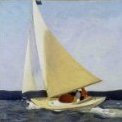
Cutter Cheerful 1806 by rafine - FINISHED
Jay 1 replied to rafine's topic in - Build logs for subjects built 1801 - 1850
Bob, your planking looks great and that's an excellent tip for planking the around the ports--thanks for sharing! Cheers, Jay- 525 replies
-
- cheerful
- Syren Ship Model Company
-
(and 1 more)
Tagged with:
-
Mike, your latest go with the fashion pieces look excellent! Also thanks for sharing your experiences with these along with how you solved getting them to look right--very much appreciated! Cheers, Jay
- 450 replies
-
- cheerful
- Syren Ship Model Company
-
(and 1 more)
Tagged with:
-

Cutter Cheerful 1806 by rafine - FINISHED
Jay 1 replied to rafine's topic in - Build logs for subjects built 1801 - 1850
After seeing your fantastic work on your Essex, and the challenges you overcame with the kit, I'm definitely pulling up a chair to see more of your magic, Bob! Cheers, Jay- 525 replies
-
- cheerful
- Syren Ship Model Company
-
(and 1 more)
Tagged with:
-
Mike, your planking looks great, and nice catch/fix on that one plank! Cheers, Jay
- 450 replies
-
- cheerful
- Syren Ship Model Company
-
(and 1 more)
Tagged with:
About us
Modelshipworld - Advancing Ship Modeling through Research
SSL Secured
Your security is important for us so this Website is SSL-Secured
NRG Mailing Address
Nautical Research Guild
237 South Lincoln Street
Westmont IL, 60559-1917
Model Ship World ® and the MSW logo are Registered Trademarks, and belong to the Nautical Research Guild (United States Patent and Trademark Office: No. 6,929,264 & No. 6,929,274, registered Dec. 20, 2022)
Helpful Links
About the NRG
If you enjoy building ship models that are historically accurate as well as beautiful, then The Nautical Research Guild (NRG) is just right for you.
The Guild is a non-profit educational organization whose mission is to “Advance Ship Modeling Through Research”. We provide support to our members in their efforts to raise the quality of their model ships.
The Nautical Research Guild has published our world-renowned quarterly magazine, The Nautical Research Journal, since 1955. The pages of the Journal are full of articles by accomplished ship modelers who show you how they create those exquisite details on their models, and by maritime historians who show you the correct details to build. The Journal is available in both print and digital editions. Go to the NRG web site (www.thenrg.org) to download a complimentary digital copy of the Journal. The NRG also publishes plan sets, books and compilations of back issues of the Journal and the former Ships in Scale and Model Ship Builder magazines.

